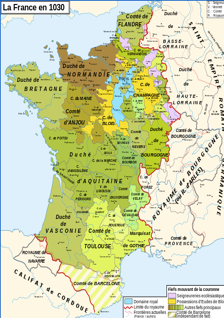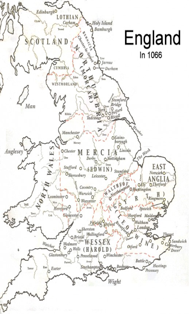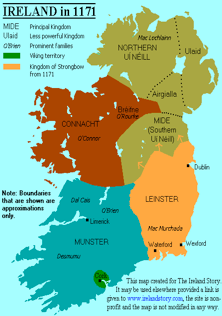5/. Conclusion/ 'Origin of the surname Sennett & its variants' Download
Wexford County, Wexford Baronies, and the Barony of Forth in the Cromwellian Down-Survey of 1656-1658
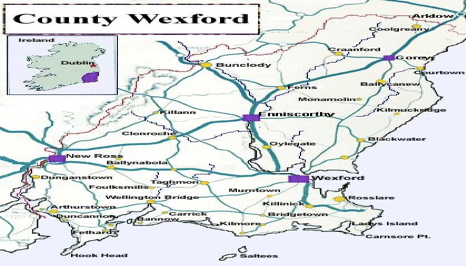 County Wexford
County Wexford
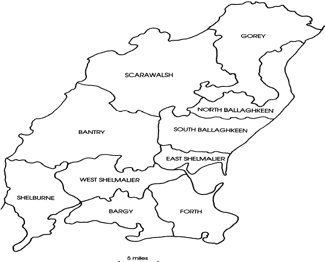 Wexford Baronies
Wexford Baronies (Barony of Forth, bottom right)
5.1/ Conclusion: Surname incidence in Ireland &Great Britain, 1640s, 1825-to-1890, 1996-to-2016, Worldwide 2018
One may choose for oneself how one wishes to describe the surname or its origin. Currently it may be safest in an historical and non-chromosomal sense, to choose from among the following typological listing,
(Map: Sennett Ballybrennan Estate in Forth, located in exact centre of Cromwellian Map, @ south west of Bay)
|
Descriptive Terminology Irish or Wexford-Irish, Hiberno-Norman, Hiberno-Welsh, Hiberno-Flemish, Cambro-Irish, Cambro-Norman, Cambro-Flemish, Gallo-Welsh, Gallo-Flemish Anglo-Irish, Hiberno-English/British Anglo-Norman, Anglo-Flemish, Anglo-French, Cambro-Norman-Flemish, Cambro-Norman-Flemish-Roman-Balkan |
Cromwellian Map, Forth Barony 1656-58 (www.TCD.ie)
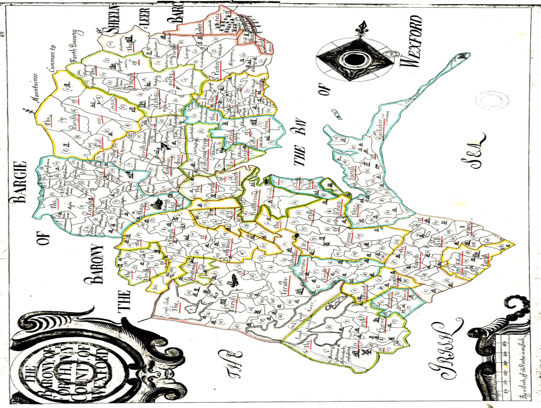 (Original map orientation rotated anti-clockwise by 90o)
(Original map orientation rotated anti-clockwise by 90o)
|
All above terms are fairly equally relevant or correct in some way up to this point in time, (even if a mouthful). Evidence of Sennett origin since their arrival in Ireland is clear. Evidence of Sennett origin prior to this, taken from the presentation above, may or may not be complete. It can seem confusing, it may be partly incomplete. However, at some point in the future, should one or more distinctive and commonly shared Y Chromosome DNA haplogroup(s) be revealed, ie. separate cohort(s) with particular and verified Anglo-Saxon or French source origins, the typological options could be expanded to cover these additional hyphenated forms of identity. For many "Sennett" name bearers throughout the world, their Wexford ancestry stretched for all of a certain period of time. It spanned at least the period between 1200 and 1850 (post Famine 1845-to-1849), a 650/700 year history in Ireland up until that point. So, the surname seems therefore to have been carried on an historic and military -and nearly always quite mercenary- flow from Flanders, through England and then South Wales and Pembrokeshire, towards South Wexford and its southern Baronies of Bargy, and Forth (the townlands of Ballybrennan & Ballydusker in particular). Soon thereafter their descendants would spread to the Baronies of East Shelmalier (Ballytramon in Castlebridge Parish, & Ballyfarnoge), Shelburne and Ballaghkeene, all north of Wexford Town. Today, the surname can be found in many parts of Ireland and in all its provinces. Its highest frequency of incidence is of course in Wexford County, and then secondly, probably Dublin County. We must go back to the Cromwellian period to find the first real information regarding surname incidence and household numbers. The additional evidence of surname numbers (by household) can be extracted from British Parliamentary surveys of Ireland and Wexford, conducted during the mid-period of the 700-to-800 year span of history as mentioned. The record of this census-proxy relates to the mid 17th Century era, a time bounded by the 2 phases of the Anglo-Scottish Stuart Monarchy (1603-to-1702). They were carried out during the post-bellum decade of Cromwell and the English Commonwealth's Protectorate between 1650 and 1660.
The Cromwellian military campaign in Ireland took place between 1649 and 1652. Cromwell himself had departed for Parliamentary business in London by July 1650, long before the campaign's conclusion. Following the completion of the military conquest, Parliament ordered a comprehensive Land and Ownership Survey of Ireland. This was followed in Wexford, Leinster and Munster by population transfer, those "Transplantations" of Roman Catholic and Royalist landowners, to the Province of Connaught. The Transplantations were implemented between 1654 and 1658. Contemporaneous to this enforced flow, a Civil Population Census was conducted over most of Ireland (26 of 32 counties in all the 4 Provinces), including Wexford County, up to year 1659. This Parliamentary-inspired Census of Ireland showed that among the then 8 Baronies of Wexford County, many of them had Sennett household (family) incidence in the order of significant numbers of families in each Barony. The recorded figures were as follows: in Forth (Si, =43), Bargy (Sy, =17), Shelmalier (Sy, =23), Shelburne (Sy, =8) and Ballaghkeen (Sy, =28), a total of about 120 families. Very few if any instances of the name were recorded in the remaining 3 western and northern administrative Baronies of Wexford at that time, Bantry, Gorey and Scarawalsh. These historic frequencies are probably much less than those of today, with the 1659 data probably as an informed estimate (re Sinnott) being perhaps nearer to only 35%+ of today's actual likely household figures for Wexford County. This is a particular feature of the Irish population profile overall compared with similar comparative historical changes in the populations of Britain and across the continent of Europe over recent centuries. More normal European populations have grown many times, they've generally grown exponentially since this period in the mid 17thCentury, with only few exceptions.
|
Table 1. Estimated 'Sennett' variant household incidence in selected Counties of Ireland at different time periods <> (There were only marginal numbers of Sennett variant households in Dublin, Carlow, Cork, Waterford, Kildare, & Wicklow prior to 1850) |
||||||
| Wexford Co. and Dublin Co. Households | Survey Years |
All Sennett spelling variants, |
Wexford Co. No. of Entries |
Wicklow Co. No. of Entries |
Kilkenny & KiidareCo's. |
Dublin Co. No. of Entries |
|
Wexford County, Townland Holdings at 1641 http://www.downsurvey.tcd.ie/landowners, |
1641 www.tcd.ie |
Sinnott Holdings | 19 cf.Tables below re Sinnott families dispersion,1stname & lands | |||
| Synnott Holdings | 56 cf.Tables below re Synnott families dispersion,1stname &lands | |||||
| Cromwellian Census, Wexford Households | 1655-59 | Sinnott/Synnott | 120 | -none- | -none- | -none- |
| Population estimate based on Reg. Birthrate | 1890 | Sinnott/Synnott | 1,000 est. Ireland Sennett total pop., Birthrate @ 37/1,000 | |||
| Sir Robert Matheson's Surname Report, Irl. | HMSO | @ Birthrate3.7% | ||||
|
Publ. Telephone Resident-Directory Hse'hlds Wexford Co.@Year 2000, Dublin Co. etc 2009 |
2000 and 2009 |
Sinnott Entries | 210 | 15 | 03 & 08 | 60 |
| Synnott Entries | 03 | 20 | 02 & 05 | 70 | ||
| Irish Land Surveys/Valuations, text below | Tithe Applotments below incl.*Sennett,Sennet,Sennot variants. | |||||
| Tithe Applotment Land Valuations, tenancies | 1823-37 | Sinnott/Synnott | c. 305 | *13 | 68 & 20 | *07 |
| Number of Tenancies listed immediately above should probably be divided by factor '2', to obtain likely Household numbers (due to multiple-holdings). | ||||||
| Griffith's Rateable Land Valuations, tenancies | 1847-57 | Sinnott/Synnott | c. 650 | 32 | 82 & 10 | 88 |
| Number of Tenancies listed immediately above should probably be divided by factor '3', to obtain likely Household numbers (due to multiple-holdings). | ||||||
| 'Land Owners in Ireland, 1876', by County | 1876 | Sinnott only,entries | 10Land Owners | -none- | -none- | -none- |
| British Parliamentary Report (GPC., Balt.,1988) | Wexford | Freeholds,1'acre+ | total 1,510 acres | |||
As regards 19th Century incidence, it should be noted in Ireland there are no comprehensive and detailed Population Census or surname records surviving from the Victorian period, the latter half of the 19th Century. Most modern Western nations would possess such historical records, but in Ireland most that remains of the period's censii are the national, regional and county aggregate figures, rather than the detailed returns of the Census forms themselves. There were however two Special Reports on Surnames in Ireland taken by an arm of Crown Government's administration in the final decade of the 19th Century. They were published soon after the turn of the Century, in 1901 and 1909. The Reports were extracted from Civil Birth Registrations in Ireland for the year 1890. They were compiled by the Registrar General's Office in Dublin for Sir Robert Matheson. (#)
Nevertheless from these Reports it is possible to estimate the Sennett variant population for Ireland in 1890. The Reports were published on behalf of the British Government (HMSO), under the imprimaturs of publishers Ponsonby and also Alex Thom & Co., in Dublin, and Eyre & Spottiswoode and later Wyman & Sons, in London. The two Reports were originally titled "Varieties and Synonyms of Surnames and Christian Names in Ireland" (1901), and secondly "Special Report on Surnames in Ireland" (1909). The two Reports provide much information on incidence, derivation, dispersion and distribution of surnames throughout Ireland. The Reports, (they were really enumerations of the record of 1890 Civil Birth Registrations in Ireland), took this date despite the decennial General Population Census being taken in 1891. Matheson restricted the survey's coverage to those names with an incidence greater than 5 persons within the national total at the date of its collation.
From the Reports it could be determined that 'Sennett' and its limited range of popular variation was certainly not among the 100 most common surnames in the country, as at 1890. This truth will not have changed. It was estimated by the Registrar's Office that the most common surname then in Ireland, "Murphy", had 63,000 bearers, while the hundredth ranking surname "Dwyer", had a total incidence of circa 8,100 persons in the all island population of the time. During the same year 'Sennett' was not amongst those 16 surnames most frequently occurring in the Birth Register of Wexford County, its highest frequency county throughout Ireland.
There were '37' Sennett-type surname 'livebirths' in Ireland during the survey year, 90% of these being in Leinster, chiefly Wexford and Dublin Counties (these together totalling 33 births, in ratio 2:1 respectively). It was also noted in the Reports that the Wexford resident registrations offered the "Si" variation of spelling only, while in Dublin the "Sy" form was the more common usage. The country's total (32 county) population in the year 1890 was circa 4.7 million persons. This 4.7 million figure is similar to the latest recorded Population Census of the Republic of Ireland (26 counties) as at year 2016. The population of the 6 counties of Northern Ireland is about 1.8 million at the present time. The population of the Republic had fallen to c.2.8 million in the mid 1950's. For comparison purposes, an interesting parallel is that since the early 1960s the populations of New Zealand and the Republic of Ireland have been pretty much growing in lockstep together from same base.
One can estimate a general Sennett variant population at the time of the Matheson work. One can do so by attributing a general 'annualised percentage birth rate', of say between c. 3% -to- 4%, to the reported Sennett 'Births' figure (the actual birth rate). Such 3-4% percentile rate can also be expressed as 30-to-40 live births per 1,000 population, per annum. The UK national population overall had a birth rate of 3.5% (c. 35 per 1,000) in the 1870s. One can by such a means iterate a range of numbers for individual Sennett persons in Ireland at the survey date in 1890. Such an estimated calculation would give a general total surname population of between 925 and 1,230, in all of Ireland at that time. The recently published major work on Irish and British surnames, the "Oxford Dictionary of Family Names in Britain & Ireland" (ODFNB+I, published by Oxford University Press in 2016, authored by Hanks, Coates and McClure), contains estimates of current and Victorian (1881) period surname population sizes in Ireland and Great Britain. It provides for each home island separately.(x)
At the point of publication in 2016, the Oxford work quotes the aggregate current incidence of the Sennett surname variants in Ireland at near c. 2,000 persons in total, c. 3,000 persons in Britain. The British (GB.) Sennett population incidence in 1881 is stated as c. 960. The work does not include a parallel comparative number for Ireland in 1881. Such a number for the Irish figure can be estimated from the above Matheson Report data as at year 1890 (estimated @ 925-to-1,230 individuals, assuming a range of Irish Birthrates of between 3-4%. The actual UK Birthrate was c.3.5% as stated in 1870s, 35 per 1.000 population). If one assumes the 37 Sennett births in Ireland were subject to a national 3.7% Birthrate (arbitrarily, for convenience), such working assumption provides an Irish estimate of about 1,000 souls in 1890. This would roughly equal the comparative British (GB) figure of 960 for that year, 1890, as per the ODFNB+I publication's data on GB 1881.
Coincidentally or interestingly, the total Irish general population happens to be similar at both points of time, in 1890 regarding the whole island, and in 2016 regarding the Republic of Ireland's population only. The Oxford work relates to an Ireland of the 26 county Republic, plus the 6 Northern Ireland counties at the present time. The Matheson book of the earlier age relates to the whole 32 counties, Island of Ireland total.
Of note in recent times, there were also commercially available certain "Burke's Peerage" editions of specially commissioned series of surname analyses (called 'World Books'). This series provided the figures for global household estimates of particular surnames under commission along with some additional background material. One such copy was commissioned for the "Sinnott" family name format (providing data for the 'Sinnott' surname only). It was commissioned in the late 1990s period, as at 1996. The resulting work offered then current household establishment estimates on a country by country basis, exclusively relating to Sinnott.
One can be left to make one's own observations from Table 2/ below. Regarding households (LHS.), the Irish, GB and USA national 'household' total number of the modal 'Sinnott' format exclusively, in year 1996 were c. 750, 950, and 1,500 units respectively. The table below highlights the relation between Sinnott household and Sinnott modal population numbers worldwide. The survey company's estimated figures were generally stated as c.40% greater than actual recorded 'Sinnott' instances in publishing company's Registry/Directory sources.
As regards GB, the representative or comprehensive British figure (England, Wales & Scotland) for all Sennett variants is currently of the order of 2,800 -to- 3,800 persons [RHS., quoted by ODFNB+I (ref x), and the 'British Surnames' website, respectively]. This range of figures should represent more than twice the number of actual British all-variant households. Statistically, average numbers of persons per household seems c.2-to-3 persons.
Worldwide, the geographic weightings of the Sinnott modal surname format seems nearly representative of the all-combined variant formats in their worldwide distribution. The ratio of 'Sinnott' in Oxford Dictionary population figures for Ireland/GB differs greatly from that of Burke's World Book's house-data series. The USA accounts for more than half of the all-variant Worldwide incidence (Ireland excluded due to non-coverage ?).
The two 'ODFNB+I' rows in middle of the table, show a strong contrast between Ireland and GB (and also USA) in terms of the range of variants in common usage. In Ireland the spelling option is binary, one form or other. It cannot be assumed from the table that the absence of many variations in Ireland might signify a separate English derivation of the other spelling formats. It may be so, but many of these particular spellings outside of Ireland in GB, USA and Australia, may essentially comprise pre-famine emigration to Britain and USA. Prior to this time, surname format in Ireland had not yet been standardised or regularised. The Irish standardisations of Sinnott and Synnott formats came subsequent to mass primary education (1830s), and secondly, the British Parliament's Catholic Emancipation Act of 1829. The Act liberated the masses in education and popular faith and enforced a co-ordinated maintainance of Parish clergy's Birth &Marriage Registers in controlling hands.
| Table 2. Worldwide (mostly Anglophone) Variant Distribution, as estimated from various sources (rounded): | |||||||
| Households 1996 | Table 2/ Worldwide: surname variant incidence (population) & distribution | Totals | |||||
| Sinnott only(NHSdonation) | Sennett,Sennott,Sinnett,Sinnott, and 'Synnett/Synnott/t' incidence Worldwide | ||||||
|
Sennett & Sennet (US) Sennette |
Sennott & Sennot Sennitt,GB.Camb |
Sinnett & Sinnet Sinnatt,GB.Hamp |
Sinnott & Sinnot Modal Format |
Synnett, Synnott, Synnot(Aus), Synott, etc, ('Sy' formats only) |
Combined All Variants |
||
| Ireland/GB. 1881 | |||||||
|
1890 Ireland-Matheson Report HMG@Estimated Birthrate 3.7%, all variants, 32 Counties estimate 1881 Great Britain -Oxford ODFNB+Irl. (from Census extracts) GB only, all variants |
1,000 | ||||||
| 960 | |||||||
| 250 | 110 | 280 | 320 | 12 | 960 | ||
|
Households in Year 1996 Source: Burke's Peerage Ltd. (Specialist Company, now dissolved) |
Source: Oxford Dictionary of Family Names in Britain and Ireland, OUP. (ODFNB+Irl.) 2016 Great Britain and Ireland Population incidence www.oxfordreference.com/view/ etc. |
Ireland/GB. 2016 Pop. Incidence |
|||||
|
Ireland c. 750 (Great) Britain c. 950 |
not significant 540 |
not significant 100 |
not significant 400 |
1,500 1,450 |
460 370 |
1,960 2,860 |
|
|
Worldwide Households 'World Book of Sinnotts' |
Source: www.BritishSurnames.co.uk/surname/sennett etc.2018 Worldwide Population incidence |
Worldwide 2018 Pop. Incidence |
|||||
|
(Great) Britain c. 950 USA c. 1,500 Australia c. 250 Canada incl.Quebec. 180 New Zealand c. 35 Other Countries n/a |
650 1,970 50 25 n/a n/a |
? 10 340 n/a 05 n/a n/a |
610 1,290 90 100 n/a n/a |
2,150 2,970 340 340 n/a n/a |
[370 c/f OUP above] 370 310 200 350 n/a n/a |
3,790 6,880 680 namespedia.com 820 n/a n/a |
|
| Worldwide Total 3,665 | 2,695 | 355 | 2,090 | 5,800 | 1,230 | excl.Ireland 12,170 | |
The more historical 17th Century surname numbers mentioned earlier above refer to Households and are available from publications produced by the Irish Manuscript Commission (IMC). The IMC reproduction of the Cromwellian Census (Household 'Poll-Tax' Census of 26 of 32 completed counties, excluding west Connaught) was conducted on behalf of Parliament by Commissioners under Sir William Petty between yrs. 1655-to-1659.
During the Cromwellian period in Ireland there were two land surveys, the Civil Survey of landholders in the 27 counties outside of Connaught (recorded by County and Barony Inquisitions) taken between 1654-1656, and secondly Petty's cartographic "chain-length mapping" land survey (aka the Down Survey, as in "laying down the chain", for measurement) of 1656-1658.(±) The information from these surveys, apart from the Census data, was mostly re-published in the 1950s and 1960s by the Irish Manuscript Commission.(&,§,+) The same Census figures, for Wexford County, are also presented in one of the works of genealogist and historian Hilary Murphy, in "Families of County Wexford"(Geography Publications, Dublin 1986).(*) The Wexford County Cromwellian Census data of 1655 to 1659 was sourced from one of only 10 available county record sets of documents where the original manuscripts survived the Crown repository fire in Dublin Castle in 1711.
Table 3. USA Variant Distribution, -N.American &Euro (GB & Irl.) geo-graphics follow (CC)!
As regards more detailed and specific USA figures one is fortunate in the information provided by two sources, the US Federal Census Bureau of course, and secondly a particular specialist modern-day website www.mynamestats.com. The site gives a detailed breakdown by variant and individual State, and aggregate.
The 2nd source named incorporates much of the available and distributed raw data from the US Bureau. From this one can construct a summary surname geo-analysis table, specific to some individual US States, as follows.
| Table 3. | USA: Surname variant incidence (absolute population & frequencies per 100k) | Totals | |||||
| USA (RJS acknowledged) | Sennett,Sennott,Sinnett,Sinnott, and 'Synnett/Synnott/Synnot' incidence USA | mynamestats.com | |||||
| Source: www.mynamestats.com and US Census Bureau, 2018 USA State by State Population incidence | |||||||
| States with the highest absolute incidence, c. 90+ individuals. | Sennett & Sennet/US Sennette | Sennott & Sennot | Sinnett & Sinnet | Sinnott & Sinnot Modal Format | Synnett, Synnott, Synnot(Aus),Synott, etc, ('Sy' formats only) | Combined All Variants c190+ | |
|
Connecticut Massachusetts New York ---------------------------- Maryland New Jersey Pennsylvania The Virginias The Carolinas Florida ---------------------------- Illinois Michigan Ohio Wisconsin ---------------------------- Arizona Indiana Iowa ---------------------------- Texas (all variants distrib'tn) California (all variants) Washington. (all variants) |
> 170 280 70 > 160 > 60 90 190 80 90 90 90 > > (Sennet)70 220 60 |
> 120 > > > > > > > > > > > > > > not significant 50 not significant |
> > > > > > (WV. & Va.) 190 70 70 80 > 140 80 > 80 > 40 110 80 |
110 > 630 180 160 180 (Virginia only) 120 130 220 170 100 > > 60 60 120 70 530 60 |
(Synnett) > > 60 > > > > > > > > > > > > > 90 40 not significant |
190 380 990 ---------- 210 190 410 380 290 450 ---------- 500 220 270 240 ---------- 190 170 160 ---------- 280 950 220 |
|
| Sennett | Sennott | Sinnett | Sinnott | Synnott | |||
| Highest frequency,p.100k | Maine 6.1 | N.Hamp. 3.5 | W.Virginia 6.4 | Alaska/Iowa 4.3/4 | North Dakota 2.2 | ||
|
States of next highest population Incidence (c. 40 -to- 90) www.mynamestats.com |
Maine Georgia Colorado Oklahoma |
N.Hampshire Pennsylvania Wisconsin |
Kentucky Nebraska Kansas |
Georgia Colorado/Oregon Minnesota Louisiana |
Massachusetts Virginia Florida |
Georgia 150 Colorado. 130 N.Hampsh. 110 Maine 100 |
|
|
Totals:<US CensusBureau > www.mynamestats.com |
2,415 2,540 |
415 480 |
1,530 1,500 |
3,505 3,735 |
380 480 |
8.245 8,735 |
|
Site Credit
Sennett
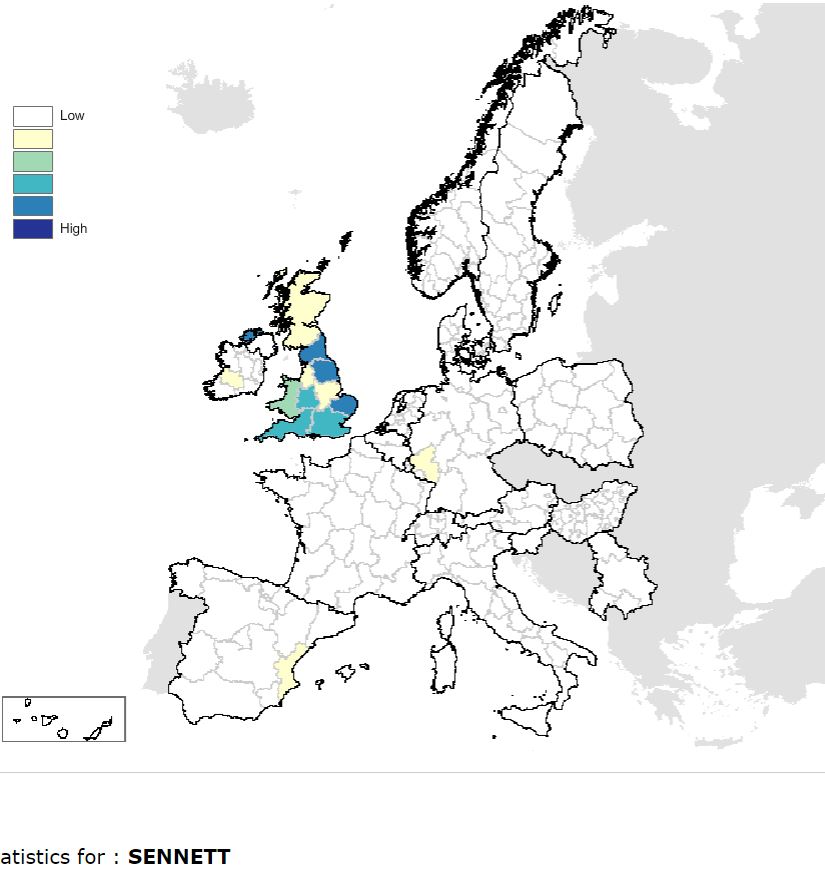
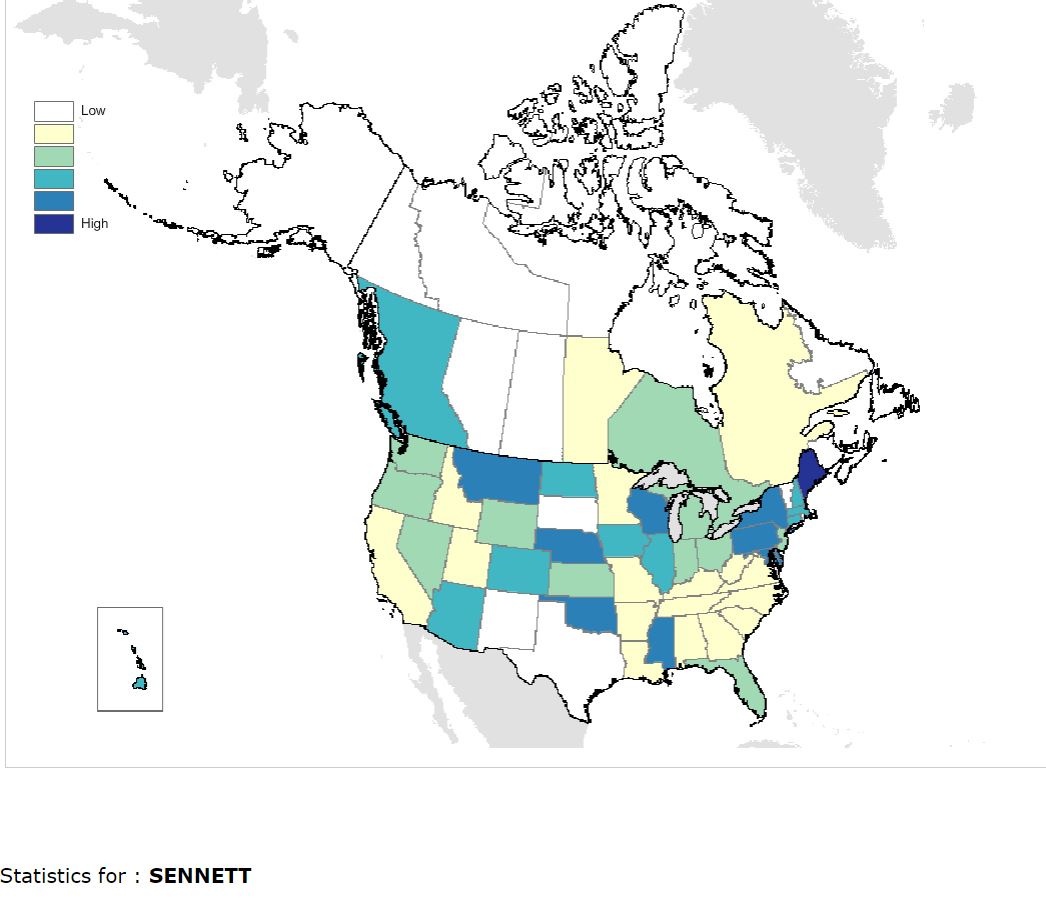
Sinnett
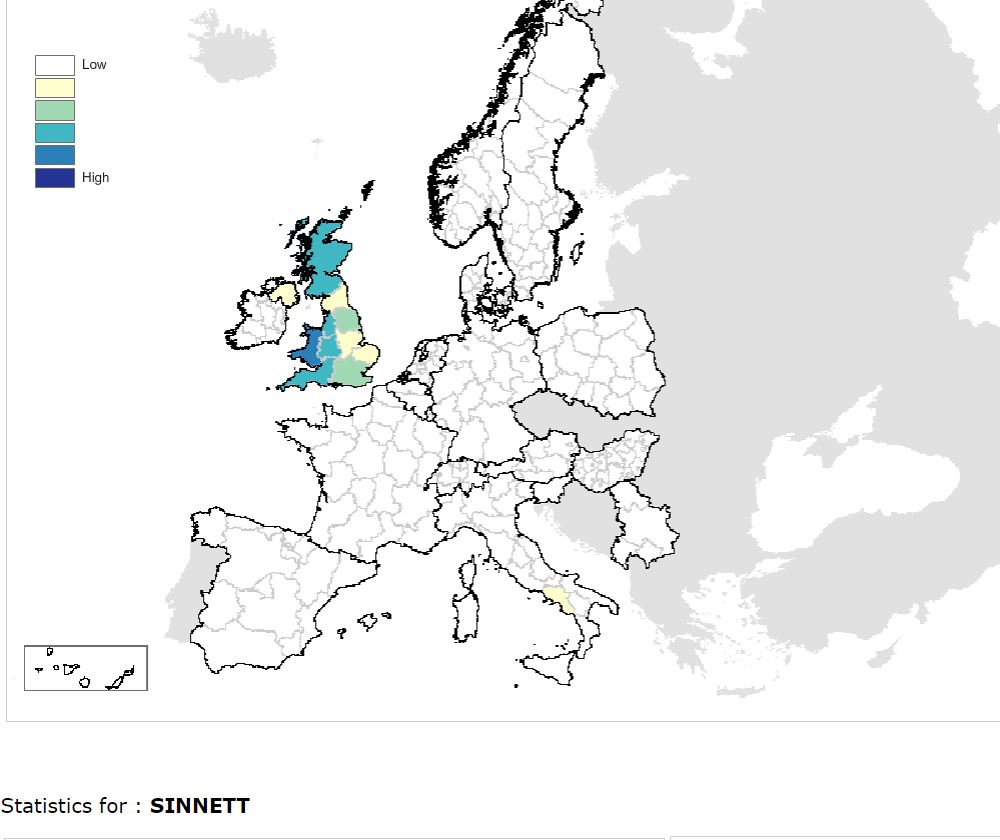
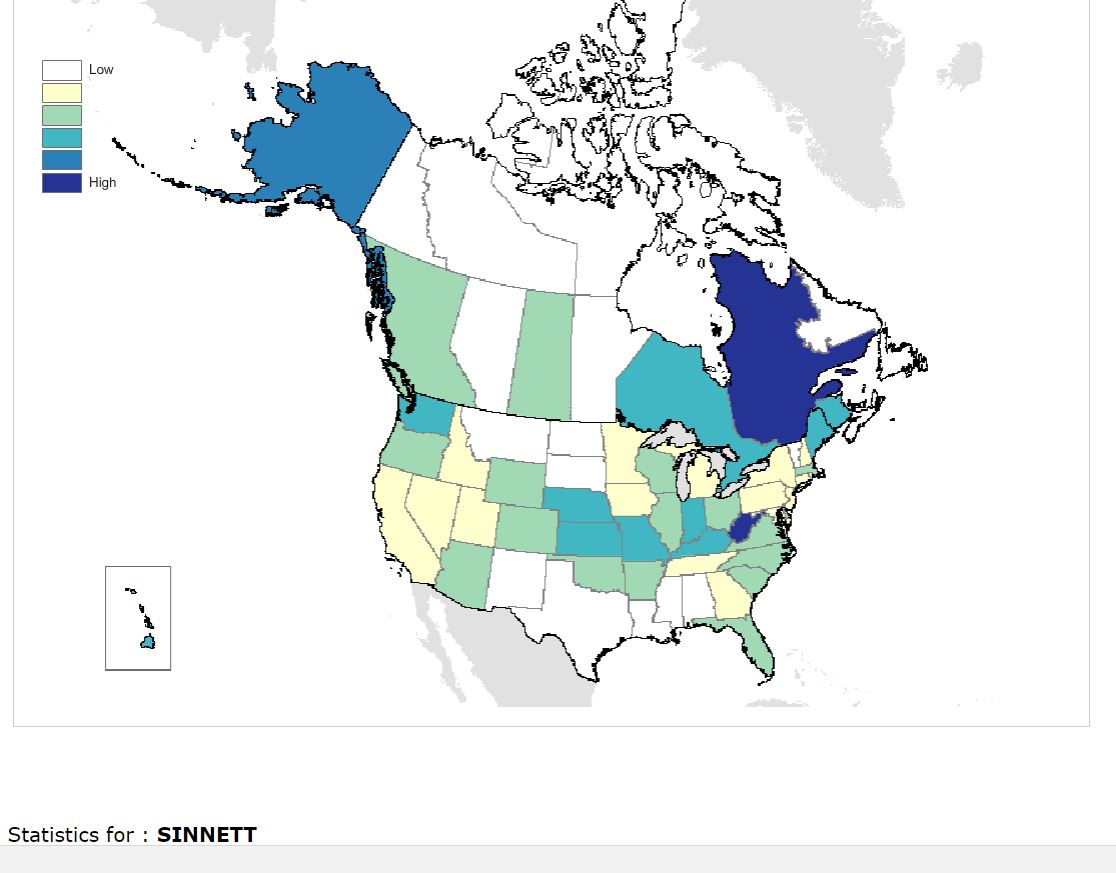
Sinnott
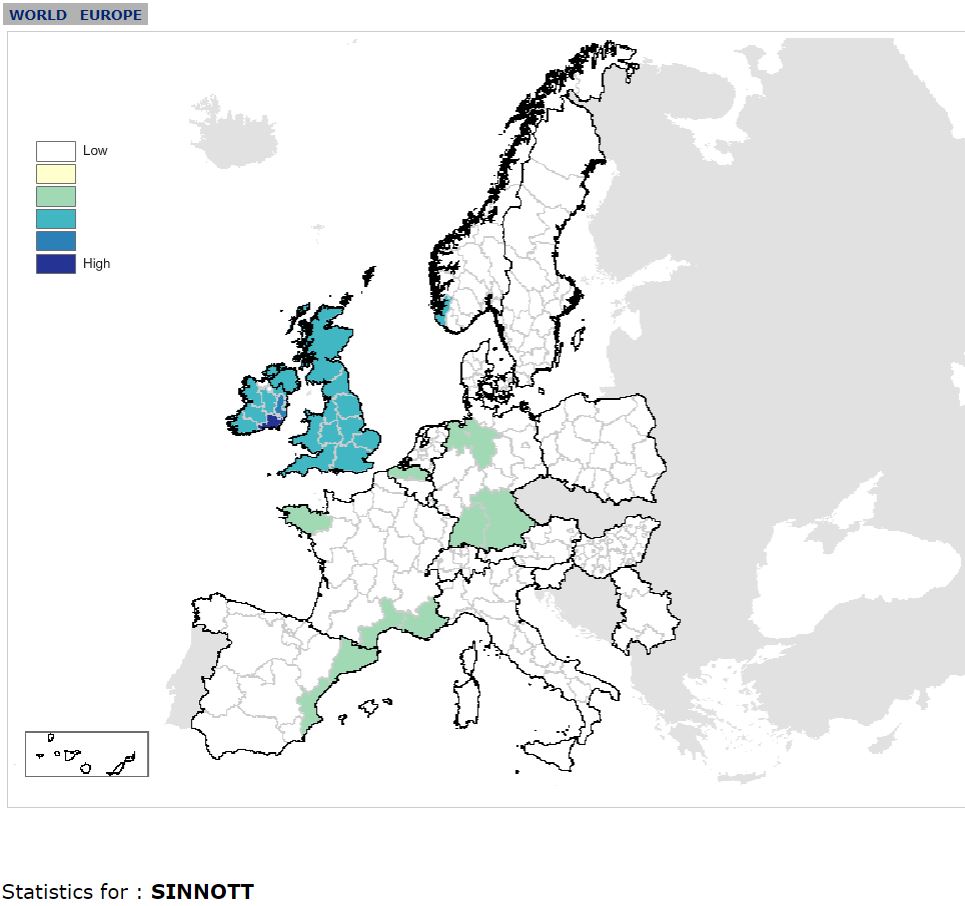
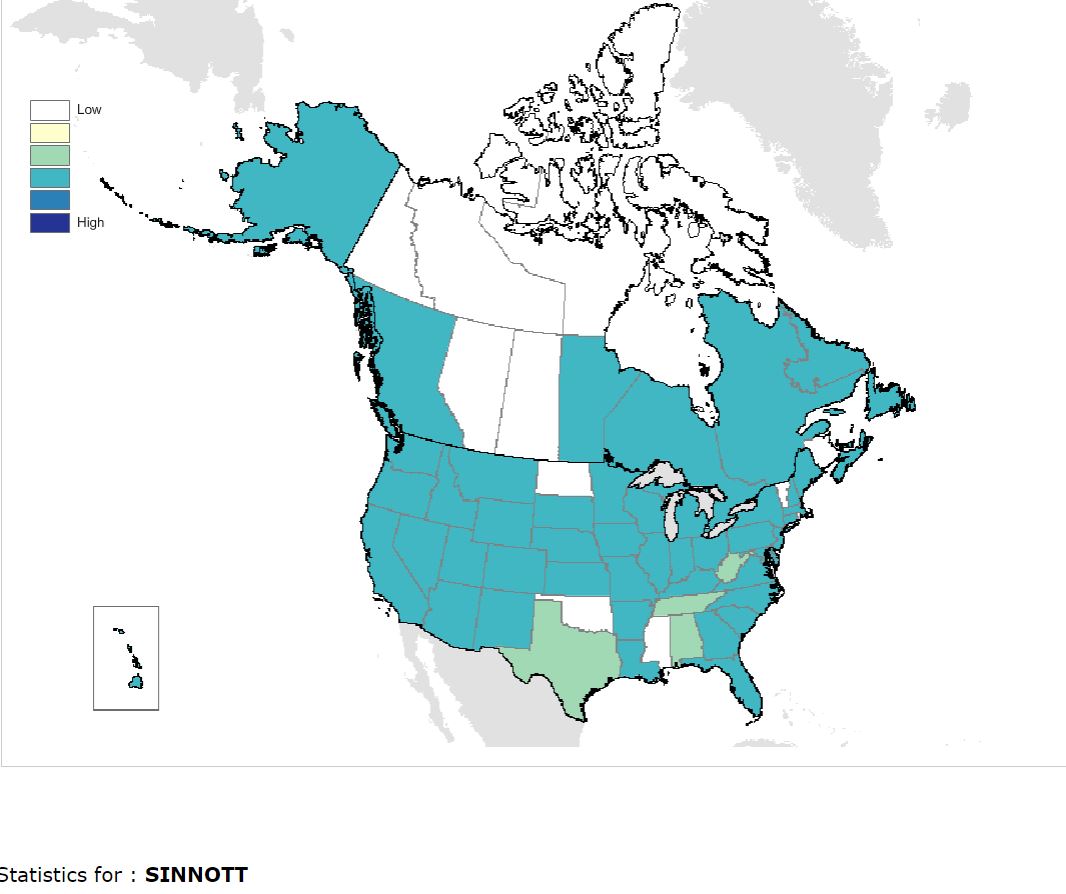
Synnott
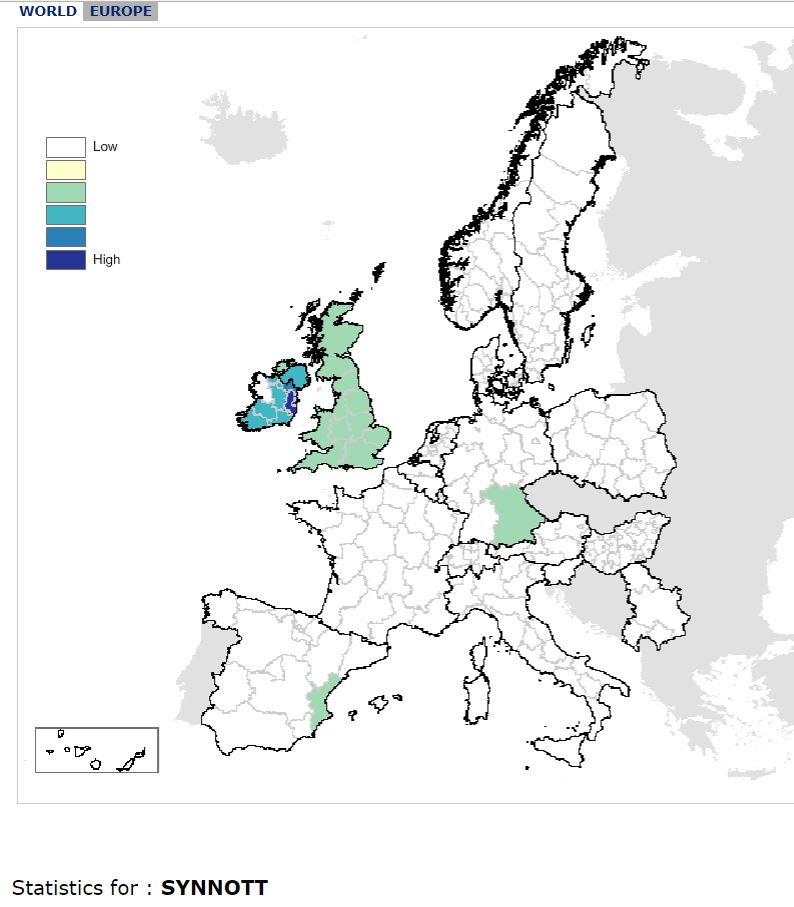
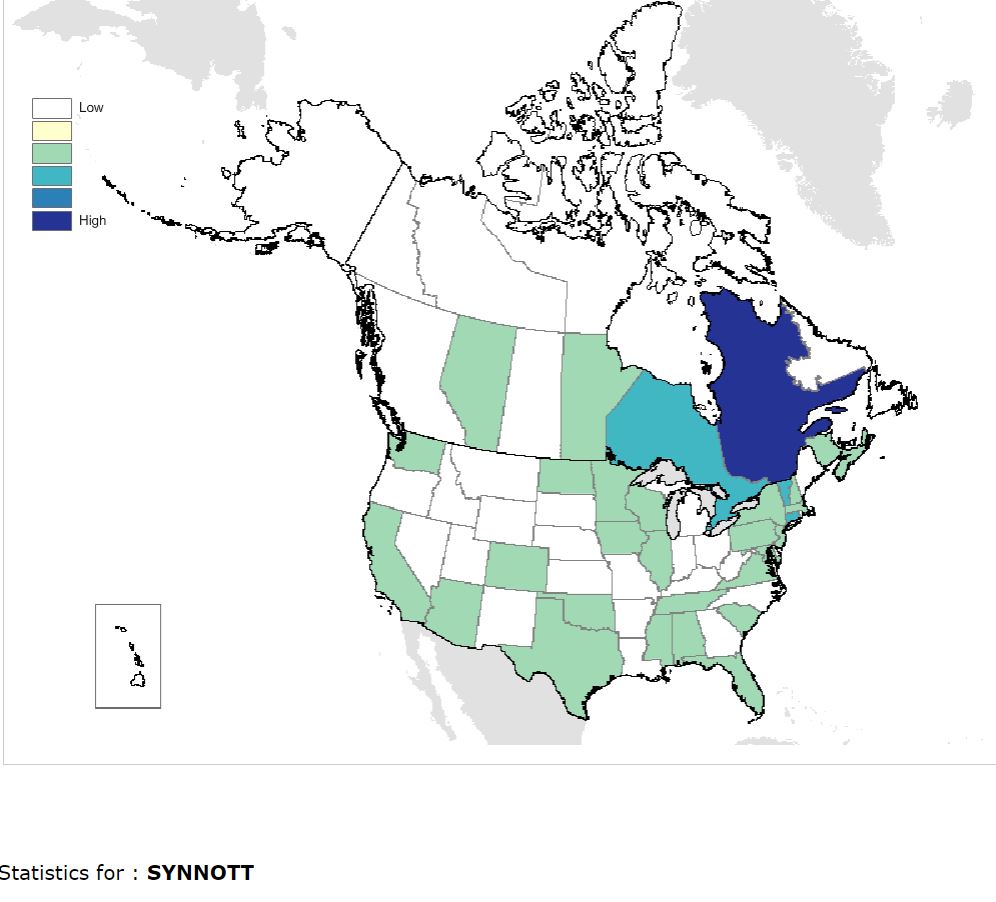
|
Table 4. Cromwellian Civil Survey of Wexford, DownSurvey, Books of Survey &Distribution 1641 Source www.downsurvey.tcd.ie, compiled for Civil Survey and Down Survey of 1650s |
|||||
|
Sir William Petty's (1623-1687) Pre-Down Survey (1656-58), Record of Wexford Townland Occupier Holdings as at 1641. (Sir William Petty was Surgeon General to the Parliamentary Army in Ireland. Previously, Prof. of Anatomy, Brasenose College, Oxford University) (There were no Landholdings under the Sennett surname or it's variants in Wexford County as at the year 1670) Source www.downsurvey.TCD.ie (Tables of occupant Landholders & Acreage in each Parish Townland can be seen on the TCD website's "Terrier" Table appendixed to each Parish Listing) (Among the individuals in many of the higher range numbers of holdings below, each 1st/Christian-Sennett name may represent more than 1 individual) |
|||||
|
The Wexford County Townland Maps by each Barony and Parish, Landholdings held at 1641-1670 are viewable on-line. # includes Colonel David Sinnott's home, Manor of Rahins/Raheene: *Mollgannon included, 'Synnot' variant (200 acres) |
|||||
| No. |
Sinnott variant |
Townland Holdings (and Parish name), as recorded under each First Name |
No. |
Synnott variant |
Townland Holdings (Parish name), as recorded under each First Name |
| 1st Name No. of Townland Holdings, 20 Holdings Total | 1st Name No. of Townland Holdings, 56 Holdings Total | ||||
| 7 | Arthur | Garryvadden (Castle Ellis), Crosshue | 2 | # David | Annaghfin (Ballyhaskarte/Ballyhuskart) |
| 790 acres | (Killilly), Barnariddery (Ballevalloe/oo), | 150 acres | Browne's Castle (Taghmon/Tamon, S.Wexf.) | ||
| Ballymore, Ballyheige, Ballylemin, and | 4 | Edmond | Meelnagh, Oulart, Kyle-Garryduffe, | ||
| Ballinrooaun (Skreene), | 930 acres | Ballyhigh/Ballyboy (Millennagh) | |||
| 6 | Edward | Ballymoty, Derry (Ballyhaskarte), Ballyroe, | |||
| 1/2 | # David | Ballydawmore,Raheene/Killabeg (Clone) | 1,010 acres | Garrynisk, Garryrichard, Ballybregagh | |
| 340 acres | [please refer to Terriere Table, TCD.ie site] | (Castle Ellis) | |||
| [located 2km north east of Enniscorthy] | 3 | Jaspar | Rathdown Ford of Ling (Ballibrennan) | ||
| Solomon Richards family,Solsborough Hse.1660 | 210 acres | Clonmore Uppr. &Lower (Ballyhaskarte) | |||
| 3 | John | Cooladine, Kilcotty x2 (Ballyhaskarte) 700 a. | |||
| 2 | Edward | Toom = Toomenemaghtery, Ballysimon | 9 | Marcus | Kilbraney, Newcastle, Loughnageer, |
| 340 acres | (Clone)[located 3km north of Enniscorthy] | 4,130 acres | Clongeen (Clongeene), Rosegarland, Rosspile | ||
| Solomon Richards &Wallop (Earl Southampton) | Ballylannan &Ballyduffe (Ballelonan), | ||||
| Maudlintown(Kilkenan),Clonmines (Clamyne) | |||||
| 4 | John | Dennistown (Kildervan), Ballydusker, | 3 | Matthew | Ballybeg/B'monebeg,Tinraheen/Tighín Raghin, |
| 250 acres | Ballyrane (Killinick), Lough of the | 410 acres | Glentire/Callern Tire (Killiske) | ||
| Ballyell Sinnotts (Kilcorranne) | 2 | Mebzer | Killannaduff, Raheenlusk (Donnoghmore) 280 a. | ||
| Ballyell Manor 1900s, T.D. Sinnott home | 10 | Nicholas | Rath (Duncormick), Lough, Craigue Lt.(Imocks) | ||
| 820 acres | Ballybrennan Big &Little, Martinstown, | ||||
| 2 | Richard | Ballybrennan (Killinick), Ballinvack | Yoletwn, Loughard, Ballycarran, Ballykereen | ||
| 60 acres | (Killnemannagh) | 2 | *Patrick | Ballytrent (Kilrane), Ballymorris/Mollg.(St.Peters) | |
| Ballybrennan Hse. 1640, Richard Synnott home | 8 | Pierce | Ballinatray-Courtown Upr &Lwr., Ballydane, | ||
| 1,090 acres | Ballinageeloge, Ballinakill, Ballybracken, | ||||
| 3 | Simon | Rathdowney Chaple (St Michaels), | Killegran, Ballyduff Lwr. (Ardimaine/Ardemine) | ||
| 225 acres | Ballygerry (Kilrane -Rosslare), | 1 | Richard | Burkestown (Keneigh, Shelbourne) 165 a. | |
| Gorteencrin (Kilcorranne) | 3 | William | Park, Ballybeggan (Carrigge/Carrick), | ||
| 380 acres | Ballintlea (Custuffe, West Shelmalier) | ||||
The above listing is of Sennett family estates in Wexford by firstname. The year 1641 was the year of an Irish Catholic Rebellion in Ulster and many other counties at the start of the British Civil Wars (in Scotland), Wars of the 3 Kingdoms. While the Cromwellian Civil Survey of 1654-to-1656 enumerated most Irish county's major estate holders and those Wexford holdings as stated above (for both Catholic and non-RC households), the actual Survey was a preparation for legal enforcement of forfeiture of estates to Parliamentary Model-Army officers and soldiers and English Adventurers (financiers of Cromwell's Irish campaign of 1649-1652). Land was forfeit for alleged or actual participation in the Rebellion or affiliate membership of the Irish Confederation.
The hardcopy publication of the Civil Survey 1654-1656 (in 1953, photo-reproduction at end, Ch.5.6/), gives a slightly differing arrangement of the relevant landholder families in Wexford County (by Barony) to that which is represented from select original source documents on the TCD site as above www.downsurvey.tcd.ie.
| Table 5. Sennett recorded in IMC-Irish Manuscript Commission's- 'Civil Survey of Wexford Co'. Vol IX: Simington (§) | ||
| Survey Cover reproduced in Miscellanea Chapter 5.6/. Table below does not show Connaught Transplantee Acreages allocated to principal parties. | ||
| The Table below shows Parish names in brackets as spelt in actual IMC Publications. They differ slightly from spellings on www.downsurvey.TCD.ie | ||
| Years | Wexford County Baronies | Sennett/Sinnott/Synnott Family Estate Holdings 1641, 1st name & (Parish) |
| 1654-1656 | Vol. IX Civil Survey Book | Many of the properties below with Castles, Manors, Mills stated as in good repair or dis-repair. |
| Forth Barony | Patrick (St.Peters), John( Kildevan), John & Richard (Killinick), Nicholas & Jaspar (Ballibrennan), Simon & John (Kilcorrane), Simon (St.Michaels), Simon & Patrick (Kilrane) | |
| Bargy Barony | Marcus (Kilkavan/Kilkeran), Nicholas (Duncormick), Nicholas (St.Image/Bannow) | |
| Shelbyrne Barony | Richard (Keneigh/Tintern), Marcus (Clonmines/Clamyne) | |
| Shelmaliere Barony | David(Taghmon/Tamon),Marcus(Clongeene),Marcus(Ballylannan),William (Carigge),(Custuffe) | |
| Scarawalsh Barony | Edward &Col.David of StoneHouse/Rahins(Cloune/Kilrush),Edward(Templeshanbo/Tampllsnv.) | |
| Ballaghkeene Barony | Pierce (Ardmine), Arthur (Killily, Castle-Ellish, Skreine, Ballyvollowe), Mathew (Kiliske), John & Edward (Ballyhuskart), David (Ballyhuskart-Annaghfin), John (Ballyhuskart-Couladine), Richard (Edermine), Richard (Kilnemanagh), Edmond (Castle-Ellish, Mylenagh), Melszer(D'mre) | |
| Bantry & Gorey Baronies | None: No Sinnott/Synnott holdings. (19 Parishes in Bantry, and 17 Parishes in Gorey Barony) | |
| Sennett recorded in IMC-Irish Manuscript Commission's publ.'Transplantation to Connaught': R.C.Simington, 1970 (&) | ||
| 1654-1658 | Connaught Co. Baronies | (*deceased individual at time transplanted ) (John?, possible additional family member) |
| Galway Co. | Clare, Tiaquin, Loughrea. | *James, Jaspar, Christian & John? of Cooladine-Ballyhuskart (to Killower), Alexander, Edmond, & Arthur (Claregalway), Arthur & John (Lackagh), Alexander (Annaghdown), Joseph (Donaghpatrick & Kilnamanagh), Anstace Synnott (Killererin), Nicholas (Moylough & Killoscobe), Walter of Carrownabody ? (Killeenadeema) |
| Mayo Co. | Tirawley,Gallen,Clanmorris | *John,Thomas & Alison of Ballyrane (to Kilfian & Rathreagh), Marcus & Martin of Rosegarland (Killedan, Kilmore & Templemore), John (Kilfian), Marcus (Tagheen & Crossboyne), Mary (Kilc) |
| Year | Wexford County Census | The Cromwellian Census 1655-1659 (+) |
| 1659 | Bantry (New Ross Town) | Nicholas Sinnott, Marie's Parish NR, tenant of Andrew Barricke, of Chaffe House., £3 rent pa. |
Finally, additional comprehensive land surveys of the island of Ireland were conducted on three occasions in the 19th Century, these all just prior to or during the reign of Victoria (1837 -to- 1901). The 1st of these surveys was initiated from the late 1820s following legislation on the collection of the Established Church's (Anglican, Church of England) annual Tithes over the preceding years. This survey is known as and is recorded in a series of 'Tithe Applotment Books'. It was handwritten in compilation, and essentially a means of raising municipal or local tax revenue. It is faithful in its detailed record to the mass of individual and common/shared tenancies.
The 2rd Victorian-period mass land-survey followed some 20 years later, The Griffith Valuation Survey. It was commenced in the late 1840s. It was to act as a Rateable Land Valuation and it recorded head-lease and also under-lease holders, leased acreage, buildings and tenements, and also land and building Rating values. It was totally comprehensive of all households, city and countrywide. It was maintained until recent times as part of the Land Registration Office (also known as the Valuation Office). Changes of household, land ownership or lease-holding and the estate's built environment were carefully recorded for Rateable Valuation purposes. The Griffith Valuation administrative record is organised by County, Barony and Poor Law Union divisions. It holds critical household and genealogical data of the full period since it first cycle completion in the mid &late 1850s.
A 3rd survey in 1876 was a comprehensive listing of all freehold/longlease 'Land Ownership' greater than 1 acre.
Surnames or family names were only coined and established in common usage in England during the 12th century, following the Norman Conquests and a revised practice by the ruling Norman elite. In Ireland the development of surname or family name patronymic formats in Irish Gaelic language and culture had already started earlier. Genealogies of particular Wexford-Sennett families are beyond remit of this paper.
(#)"Surnames in Ireland", Sir Robert Matheson, {2 Vols in 1}, GPC, Batimore'1988,HMSO'Special Reports 1901/09.
(*)"Families of County Wexford", Hilary Murphy, publ. Geography Publs., Dublin D12'1986,Printshop Wexford.
(x)"Oxford Dictionary of Family Names in Brit.&Irl.",P.Hanks, Coates &McClure, OUP'2016 ISBN 0-19-967776-4.
Also www.BritishSurnames.co.uk/surname/sennett, www.namespedia.com, www.mynamestats.com
(+)"Cromwellian Census of Ireland,1654-1659", Ed. Seamus Pender, IMC-Irish M'scrpt Comm., Dublin'1939.
(&)"Transplantation to Connaught", R.C. Simington, IMC-Irish M'scrpt Comm., Dublin 1970. ISBN 0.7165.0506.1
(§) "The Civil Survey of County Wexford"1654-1656, R.C. Simington, IMC-Irish M'scrpt Comm., Dublin 1953.
(±) "The Down Cartographic Survey", net publ. TCD-Trinity College Dublin, view www.tcd.ie, http://downsurvey.tcd.ie
Chapter 5.2/ [4x pages A4 text] Sennett 'Modal' Haplogroup, E-V13.(pre-Bronze Age). Surname DNA paternity marker, a specific Y Chromosome haplogroup [E-M35/E-L117, E1b1b1a1b1a, now E-V13]
As genetics science has advanced so has the technical classification by which most Sennets could be affirmed. This code has become more extended with time, E, E1b, E1b1b, E1b1b1, E1b1b1b (E3b), E1b1b1a1b1a, etc. This is the collective male genetic marker for all male 'Sennett' descendants. This marker in a way represents the current sampled group's most distant and ancient but common ancestor. The living Sennett universe are all theoretically descended from this one individual. This is a fundamental truth with regard to all ancient human life's genetic lines that survive today. The Y chromosome DNA testing confirms or disproves that linkage to the common Sennett ancestor of the ancient or very very ancient past by registering in a common Y chromosome haplogroup.
The relevant genetic markers for the Sennett core Group1 universe as was stated in Chapter 1.1/ is "E-M35". This coding has parity with the "E-L117" classification. They are both post-Paleolithic but pre-Chalcolithic classifications (just before early Bronze Age). Some of the early Sennett individuals sampled had historically been given the equally relevant labelling of an "E-L117" haplogroup. One could really say now that the single-haplogroup genetic marker is mutually shared between its two labels, its 2 haplogroup classification names. They are both coded forms of expression and the commonly shared genetic markers of the core Group1 Sennett cohort from an ancient past. These classifications relate only however to the Group's very very ancient common genetic heritage, and to the sampling cohort among the greater Sennett universe and heritage that have been tested to date. More recently the haplogroup has been brought forward or refined to that of the "E-V13" haplogroup. This is just a very ancient heritage. The process of conversion or of upgrading the former classified member persons upwards "down the phylogenetic tree" from the E-M35/E-L117 haplogroup, and towards E-V13 may take some time. A Group Administration is best placed to manage any directional process.
*Modal 'E-V13' -Y Chromosome DNA Haplogroup (*Note <10% frequency in Belgian 'tip' location @ Val de la Sennette.)
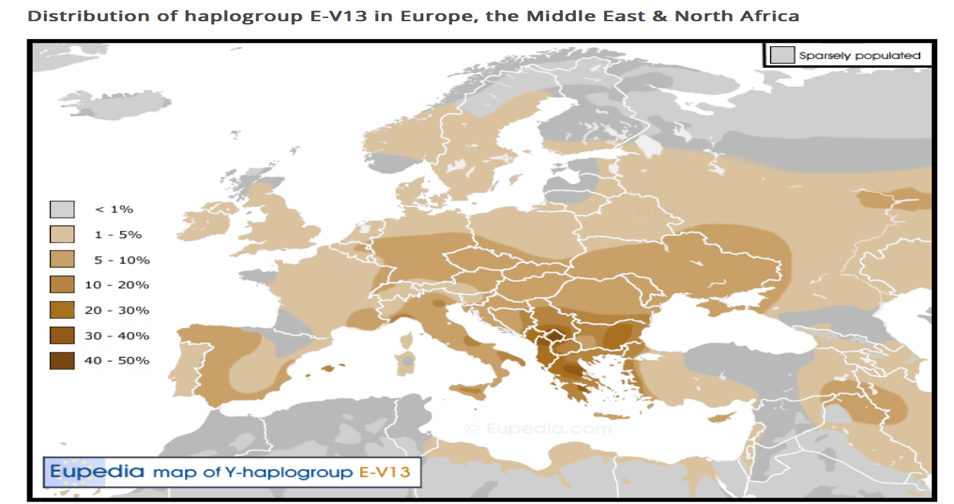
(Note: This Eupedia chart also appears in Chapter 1.2/ and a smaller version on the page following)
Generally as one strives in life, one may also strive to move the accurate classification of a cohort's haplogroup more towards the present time. By this means one can further define and refine a shared marker. In common parlance or proper terminology and also still within the geneticist's jargon, one might say, move the marker further along the 'Phylogenetic Tree' in a process of discovery. This is the purpose of further or advanced testing for all individual members and future members, to move forward in time in a linear process and by a series of test exercises, thereby refine the degree of genetic history and information sufficiently enough, to advance the point-in-time of the latest known common antecedent. Such an individual, if identifiable in modern history, may often come to be known as an EKA-'earliest known ancestor' (or MDA –'most distant').
From the very limited test base assessed to date (at mid 2018), one can not yet define accurately a more recent common ancestor's marker classification. To exercise such a refined analysis one requires more refined testing. Further testing should take the Sennett haplogroup further down the genetic tree, the phylogenetic tree, through all of its antiquity and ancient history, towards our more modern time. This might hopefully permit us at some point to connect or intersect or overlap with … our own more recently recorded family genealogies.
Genetics could be seen as a modern, scientific and more realistic form of time-travel. Some might call its utilisation and expedition in looking through past time as a study "de temps perdu". One can take an ancient ancestor and move their genome in a packaged and labelled form forward through time. The most sceptical might call genetic genealogy a form of time-travel with your ancient ancestors, a modern mastery of past time.
At the current time, the "E-M35/E-L117" haplogroups define for most members our very ancient common classification. From this point, a very limited subsequent series of tests can attribute or ascribe the genetic path for the Sennett cohort, the Group1 set, through further haplogroup test upgrades (usually using 'STRs', the simple or short tandem repeats of chromosome genetics). Later stage sample testing can be conducted using SNPs or 'single nucleotide polymorphism' teasting, a binary test process within the long-hand version of genetics convention). One can most simply and quickly probably refine an existing test sample down to the nearest common "E-V13" haplogroup. This is now the modal Y chromosome genetic marker for Wexford Sennett descendants in Ireland. It is equally and naturally the haplogroup of those of the surname whose ancestors may have migrated from Ireland. The marker is shared by the large majority of Sennett and related variant surname descendants, and a unanimity among the initial primary Sennett grouping, the 'No.1 Group'.
From this point onwards one can follow on a fairly expensive full test assessment to refine and define a fuller and more precise terminal point of ones genetic identity. This is called a 'BigY' dataset (cf. RMS, JES @ftDNA). A lower-cost route should be (if one is correct or lucky) by means of a sequence of limited and pointed SNP tests (SNPs or Snips in the vernacular, ie. "single nucleotide polymorphism" tests). These tests might take the group beyond the "E-V13" haplogroup set in search of a more refined 'nearest terminal identity', if or when the group members so wish or are so requested/directed. There need be no rush to exercise such an option.
Europe: R1b Modal Haplogroup, Ireland
Haplogroup Density: Ireland 'R1b' Modal 82%.
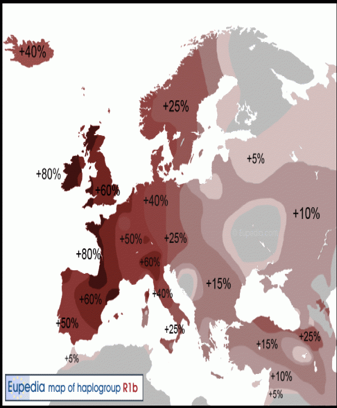
Balkans: Slovenia, Croatia, Bosnia, Herzegovina, Montenegro, Serbia, Nth.Macedonia.
Old terms : Illyricum, Dalmatia, Pannonia, Moesia, Macedonia, Dacia, Thracia, Epirus
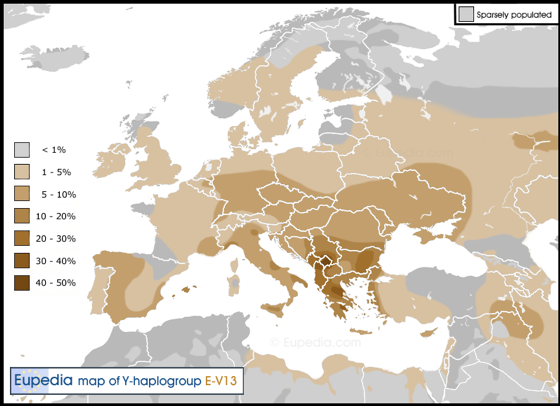
(Note: Both of these charts also appear in Chapter 1.2/, the Eupedia map of 'E-V13 appears on previous page).
The Sennett surname Group(s) is administered within the registered membership of the www.familytreeDNA.com website.
This is the popular medium for Y chromosome registration, it aligns with the Guild of One-Name Studies, on the website alternative https://one-name.org/name_profile/sennett)
The Sennett Group represents to date, those males named Sennett, and similar or common variants who have elected to take the sampling test. They can trace a paternal ancestry back to Wexford County or Ireland generally. There is a slight possibility this geo-genetic blanket could cover parts of Britain eventually also, but that possibility is most uncertain as at the present time. The possibility of a true British or Anglo-Saxon genetic origin for the Sennett and variant surname looks ever less likely, especially as sampling progresses, with time. The results to date of the moderately sized Group1 sample group suggest this. More testing is required, from more people (males), especially if possible more indigenous British or Anglo-Saxon male Sennetts or variants.
For many years within the post-Roman timeframe, England was a battleground between Britons and Anglo-Saxons and later those Danes and Norsemen going Viking (Viking as a verb). Hence the regional county names, Essex, Sussex and Wessex. A particular migratory example would be the Germanic warrior leaders, the duo of Jutes, Hengist and Horsa (or Horst). They were a real life rather than mythological duo. The post Roman migratory influx was of north Germanic tribes, Frisians, Angles, Jutes, Saxons and Danes. It should be more probable following such an influx of peoples (though not at all a certainty), that if a primal progenitor Sennett was endemically or typologically Anglo-Saxon, the haplotype marker should probably prove to be classified from within the following historic continental base configurations, from those among the 'R1a', R1b, 'I', or 'N' prefixes of Y-chromosome DNA markers. One would not expect ancient 'Anglo-Saxons' to have an "E" haplotype prefix any more than might be the case with ancient 'Flemings', but it is certainly possible. Wexford Sennetts are part of this unusual "E-V13" marker group. Admittedly, one must say a genetic marker could be culturally hosted by Germanic, Anglo-Saxon, Flemish, Welsh, Norman, French or Briton, even if not seeming to be ethnically or genetically so. This would be the case today. Indeed, in the modern world of globalisation and mass migration, many varied genetic markers can be found among most western developed nations. Ireland today is still a little exceptional in its mass homogeneity (hot-spot) of the primary haplotype, the "R1b" (82%).
A true Anglo-Saxon identity for a 'Sennett' within the current "E-V13" genetic test group would require, although it seems most unlikely, that the main Sennett "E-V13" haplogroup which already has strong and confirmed historical Mediterranean and European sub-sets, must also have had a defined former Anglo-Saxon or Germanic sub-set. The "E-V13" haplogroup is a definite Irish sub-set, and a very clearly demarcated and delineated micro-set in Ireland, that of the Wexford Sennetts,. The Anglo-Saxon line would need to have been derived from a very early historical branch of the same Sennett European 'tree-trunk' and its antecedents. This cultural divergence of genetic paths would need to have occurred prior to proper naming conventions. In all realistic probability, the Germanic line would have been identified under another vernacular name, and in another language. Such a prospect is still awaiting confirmation among all the future potential Anglo-Saxon test samples. It will remain most unlikely. In a nutshell however, such a hypothesis would mean that two possible lines of Sennett, under whatever early historical names, had somehow separated before or during the Bronze Age, or at some stage in early human or later Roman history, and then that they both eventually adopted the same pre-modern surname. The ancient Anglo-Saxon branch might have just fortuitously stumbled upon or coincidently acquired within its own dynamic heritage or society a Sennett variant surname. This name then by a natural process over time, happened to converge in usage towards that of Sennett used in South Wales or Wexford. This would be a true miracle of the social calendar in all of western civilisation. It would indeed make our surname group rather special in the genealogical world. Such is unlikely to be the case.
A far more likely possibility is that a family or sept of Anglo-Saxon origin, but of a different genentic haplogroup, had adopted through time a surname that tended towards convergence with one of the many spelling varieties available to the Sennett septs or clans. It is not important which particular Sennett variant was so chosen to act as a convenient surname. This historical circumstance in the old England is a possibility that can face a real prospect of discovery with the passing of time and the testing of more research samples. It would certainly not be an unusual possibility or a totally unexpected outcome.
This possibility would clearly be contrary to the more Belgic case set forth in this thesis, that of its Flemish origin. The Sennett "E" haplotype marker, if it were to have an Anglo-Saxon origin, must likely have been brought to Britain during the mid-first Millennium's Germanic settlement of England. It may be more correct to say, that the "E" haplotype given its wide and general Afro-Mediterranean and later European origins, would have been carried to Saxon England within a Germanic cultural envelope or migratory flow. East Anglia and the eastern coastal region of England, as stated above, had been settled from the European continent over the long post-Roman and pre-Norman period, a period of 600 years. The common 'E' haplotype has a human geographic and sequential association with Africa, the Mediterranean and then in later time the Europe continent itself. Perhaps more reassuringly to those surprised by the "E" prefix haplotype, it can be said the E-V13's phylogenetic haplogroup has a sequence of particular sub-sets.
These sub-sets should be seen as later in time and nearer to today and also, through their identification, a means by which one can move one's haplogroup further down the genetic tree towards our modern times. The classification terms for such refinements are referred to as being that of the haplogroup's 'subclades'.
Some note can be made of the particular E-V13 haplogroup at this point. The group is rare in both Ireland and Britain. It has slightly higher frequencies (ie. high single figure percentages of sample of up to 10%), in modern Belgium and the old inland pre-unification German Federation and Holy Roman Emperor's cities and Elector-states. The grouping is spread to a very similar degree across most of inland central Europe, eastward all the way to the Ukrainian-Russian border. It could be said that this currently troubled border region is the European front door to the wide and great Russian Steppe. It could be seen as a door that opens both ways, like a cat-flap. In ancient history, after the ice retreated small-scale human tribes moved from a practice of hunter gathering to one of farming and crop growing and the domestication of animals and even the riding of horses, all within a newer and warmer Europe. The current European/Steppe border zone was then a door into Europe. There were other open-doors into Europe through the Middle East and Anatolia and Greece and Spain, and across the more predictable Mediterranean seas.
Interestingly the E-V13 hot-spot lies near an ancient, some might say quite multi-faith, multi-ethnic and multi-cultural region of the central Balkans, Bosnia & Montenegro. A surprise for some perhaps. It points toward an origin in these Balkan parts of the Mediterranean in not only ancient Roman but pre-Roman and pre-Classical times. This was a time before Greece was in or approaching its ascendant phase, its early Hellenic period and then its great classical period. It is an Illyria some few millennia before us today. This Illyrian and Adriatic region was known as Illyricum and Dalmatia in the Roman period. Greece (or Hellas) itself was known in that time as Epirus and Achaia. The region has always been and remains a patchwork quilt of shifting Kingdoms and rulers and alliances, and of identities, religions and cultures (In such matters as these afore mentioned it has through history shared one type of fate, if not all faiths, of the Low Countries, that of a greater Netherlands).
The highways of that time were often local seas apart from the Mediterranean; those of the Adriatic, Ionian, Aegean, and the Marmara and Black Seas. The great canon of Sennett knowledge can still prosper without knowing the ancient Latin translations of the Balkan Kingdoms and Seas. The Dalmatian Coast and Bosnia and Herzegovina and Montenegro as with the Thracian lands, another more eastern Balkan state on the Black Sea (Bulgaria today), were all neighbouring states to the homeland of the Great Alexander. This Balkan connection and an E-V13 haplogroup identity may be that of a Roman Auxiliary Legionary's identity, one later acquired by a particular native Fleming mercenary and then thereafter perhaps engaged by his ascendant Cambro Norman employers. It might imply a figure in antiquity raised and schooled and trained within a day's ride of Alexander the Great's modest Kingdom. It may be that Alexander or Phillip of Macedon's martial traditions were practiced and conscripted and spread throughout the central Balkans. The war-like ways of that place in Roman times were perhaps carried to Flanders in pursuit of expanding the Roman order and its law at the frontier, the northern extremity of the continent. Knowledge of warriors in same mind and of the same mindset, those with the wandering or greedy or war-lust propensities of the Flemings and Cambro-Flemings and Normans and later Anglo-Britains alike, should really therefore come as no surprise. The Greeks of Alexander the Great's time, then the Romans and then Vikings, each possessed this old mindset. Alexander's homeland of Macedonia is today in process of changing its name, as one goes towards a final print.
The latest available information regarding the www.familytreeDNA.com member's group analysis should probably at this point be presented in two dimensional graphics. The E-V13 haplogroup is the farthest point yet travelled in approaching the modern period from our very ancient past. In time with further testing, this benchmark will be moved forward in time, nearer to that era of our modern history. The charts below may provide an easier means of explanation and understanding than that so laboriously offered above. Hopefully their viewing is less trying for all. So to understand in a graphic sense where the Sennett cohort are today, one must consider DNA research and the sampling and testing and that soft light both have shed on our ancient pre-historical and pre-Bronze Age common past. Please consider the graphics below. The E-V13 marker classification has taken us only so far to date in moving towards the modern genealogical record and documentary evidence of modern times. The few graphs below may help in one's general understanding of modern Y-Chromosome genetics. All volunteer new members are most welcome. An explanation of an apparently Balkan, Dalmatian, Bosnian and 'Illyrian' identity follows below. Given the great waves of humanity moving out of Africa before the time of recorded civilisation, moving through the Middle-East and Mediterranean in pre-Religious times, moving into the great Russian Steppe and the farther regions of Siberia and Central Asia, the passing of a late migration of new farmers and tillers of the soil and horse-riding tribes through or into Anatolia and Greece and the Balkan regions should come as before, as no surprise.
Two Phylogenetic Trees ['E-V13': ---> LHS (left) Stream, E-M35.1, E-M78, E-V13][RJS & CC. acknowledged]
Sennett "E-M35.1/E-L117" +(E-M78) +(E-V13) Haplogroups on Phylogenetic Tree (a Paleolithic Red Sea group, E1b1b)
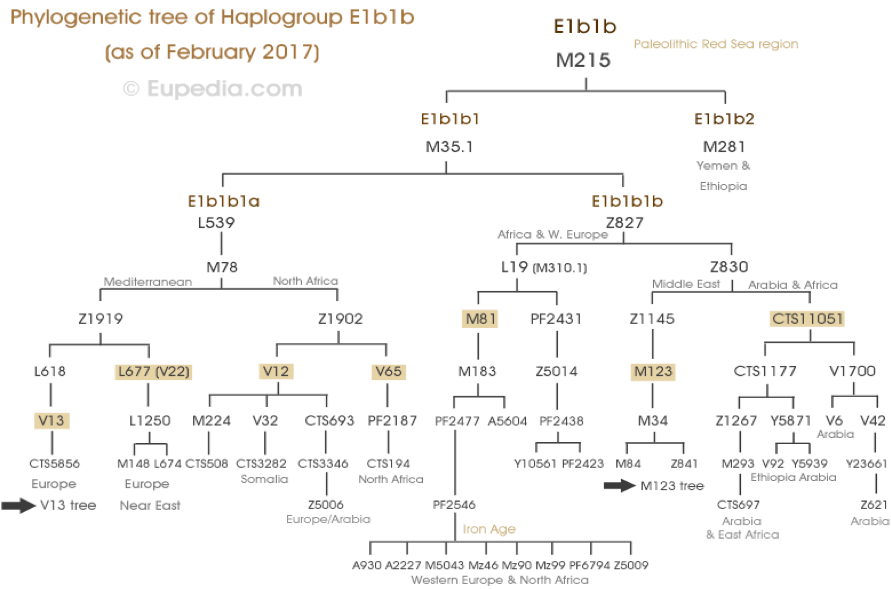
Sennett: "E-V13"(@ mid 1st Row) Haplogroup E-V13 'Sub-clades' on Phylogenetic Tree, post Early Bronze Age.
(Final full page of Chapter section 5.2/ shows 'descendant subclades of 'E1b1b1a1b1a' relating to 'E-V13')
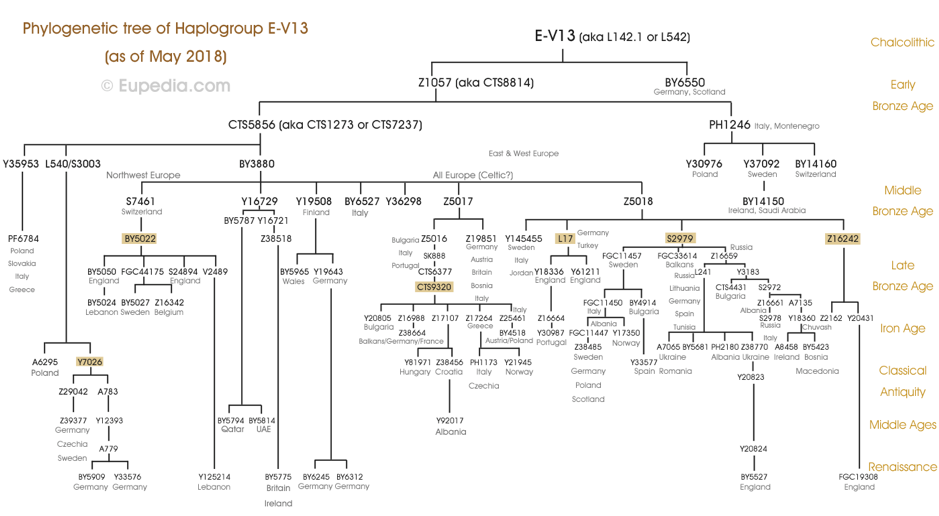
European Dispersion of Haplogroups E-M78 (&E-M35) & E-V13 through the Levant to Balkans, c.9500-6000 BC
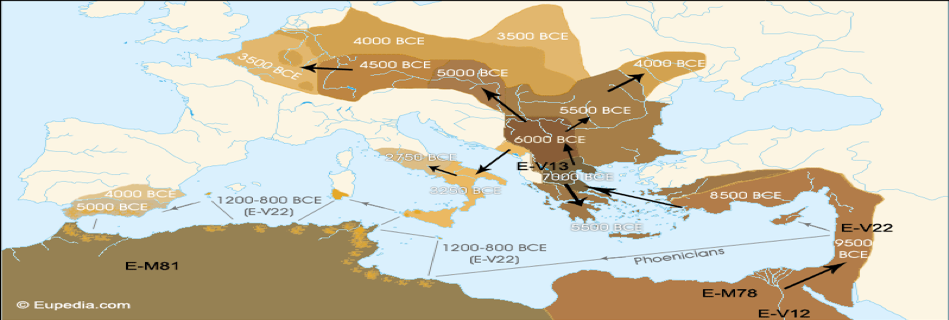
Copper Age Diffusion in Europe 6000 Years'BC -to- 2000 Years'BC
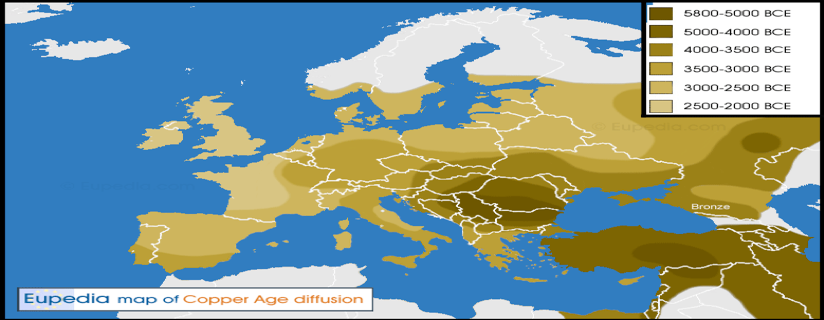
Alternative graphic re 'E-V13'(E1b1b1a1b1a): website http://bosnjackidnk.com/v13-starobalkanski/

Ancient Migrations History: 60,000 Years to 5,000 Years ago: and 3000 Years'BC to 2000 Years'AD (Today)
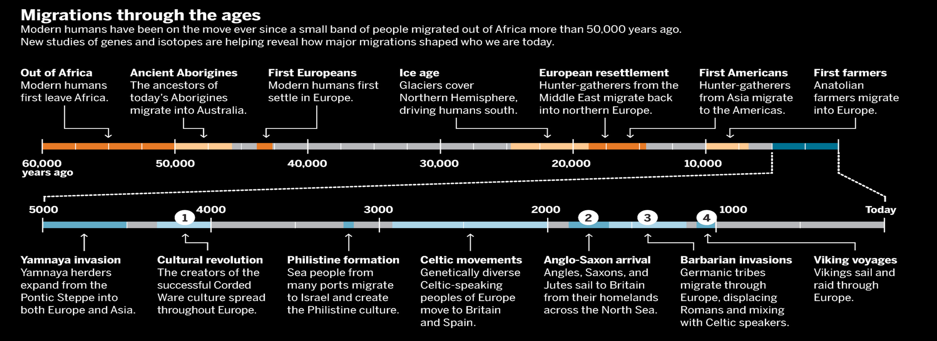
Potential sub-clades for future SNP testing of E-V13(E1b1b1a1b1a, & L542,V36,CTS2374, c/o CC)
|
'reformatted or unformatted' BY6550 CTS8814 CTS5856 S3003 A6295 BY5850 BY5854 Y7026 A783 A1157 Z29042 BY5193 Z39377 Z16663 BY15396 BY15395 BY15408 Z21371 BY28623 Z5018 L17 BY5219 BY3880 Z5018 A2192 BY6100 L143 L17 BY5219 SK1877 S2979 Z16659 Z5017 BY4642 BY40492 Z38334 BY4684 FGC71980 Z19851 BY6203 BY6350 BY6420 BY6269 BY6270 BY6527 Z38899 BY7425 S3003 A6295 BY5858 Y7026 S7461 BY5022 PF4666 Y84162 Y19509 BY30351 Z1663 Z19851 BY6202 FGC14092 Z38334 BY4686 BY4700 Z5016 BY4610 CTS9320 SK888 Y16729 BY5750 PH1246 BY14151 BY14160 BY14150 L142 CTS10905 BY34237 CTS10969 .… BY34236 BY34239 CTS1653 BY15549 BY28615 CTS246 BY44792 CTS4122 CTS7373 CTS8746 F2981 F3242 F4266 L17 CTS11715 L468 BY5784 P226 P53_3 PF1254 PF3067 PF4984 PF5709 PF6395 PF89 Y16734 Z175 S3003 A6295 Y7026 A783 Y16713_Z38518 Y16733 Z29042 Z38899 Z5018 A2192 L143 BY6219 BY6238 BY6318 BY6317 BY6375 BY6364 S2979 BY6125 FGC11457 A9479 BY4925 BY5020 FGC11451 BY143121 BY4835 FGC11458 BY4914 FGC33621 A10158 BY6132 FGC11447 BY6162 BY6163 Z16659 L241 A7065 FGC11450 Z16242 FGC61651 CTS8690 S9725 F2524 Z24130 Z38770 Y3183 S2972 A7136 S2978 Z16661 |
'reformatted or unformatted' BY5841 BY5185 BY5200 BY5227 L241 Y3183 BY4700 BY4715 A783 BY5862 BY5890 BY5930 Z29042 BY30352 BY5029 …. BY5050 BY5145 BY5465 FGC11445 BY6201 BY5948 BY5979 S19928 Z16988 Z17107 Z17264 BY4600 CTS6377 BY40548 BY5794 BY5812 Y16713 BY5856 BY5909 A14363 BY5500 BY5617 BY5650 BY5672 Z38770 BY44794 BY5350 BY5375 …. S2972 BY5841 BY5860 BY5900 Z39377 BY35780 BY5152 BY5090 BY5438 BY5160 BY6245 BY6312 FGC14091 Z27131 Z38664 Z38456 BY4280 BY4366 BY4590 CTS9320 BY40482 BY5803 BY5807 BY5822 BY5828 BY5750 Y16733 BY4975 Z38519 BY4991 FGC11444 Z24130 BY50699 BY4948 BY56509 BY5923 BY45611 BY5570 BY5610 BY5621 PH2180 BY5550 Y19527 A7135 PH3589 BY5505 BY5522 A7136 BY5293 S2978 BY5515 BY5540 BY5600 Y18675 BY5285 BY5527 BY34331 FGC14285 Y18673 BY4500 BY5047 BY5430 BY5431 BY5423 Y129143 BY36670 BY5140 BY20093 BY4526 S19928 Z16988 Z17107 Z17264 BY5794 BY5814 BY5804 BY5805 BY5751 BY5766 BY5775 BY5150 BY4523 BY20073 BY4507 BY4197 Z27131 Z38456 BY4280 BY4309 BY4348 BY4366 BY5803 BY5807 Y85963 BY5810 BY5837 Y92832 BY5776 BY5103 BY4543 BY34282 Z38664 BY4225 BY62310 BY4459 BY4282 BY5804 BY5805 BY5811 Y94747 BY5808 BY6900 BY34308 BY50887 BY34314 Y92017 BY4339 BY5810 BY6901 BY19731 Z38485_Y16160 BY4793 BY4856 CTS11286 Z21291 FGC11447 Z38485 BY4975 Z38519 |
Chapter 5.3/ Sennett, Sinnott and Synnott Heraldry and sources relating to Arms, Crests, and Mottoes
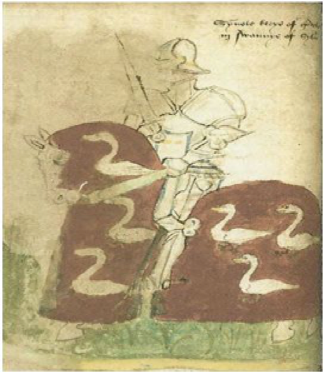
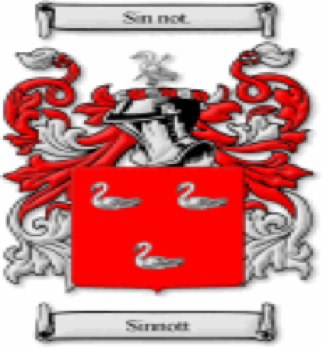

Text: Earliest depiction of Synnott Arms c.1470
"Heraldry and the Synnott Coat of Arms", c/o David J. Synnott, 2010, Sark, unpublished.
[LHS] The illustrated equine heraldic-citation as follows, "Synote: Berys of Gules,lll (3) Swannys of Sylvr",
from Le Neve's "Equestrian Roll/Creswick's Book", British Library, Euston Road, London, Additional Ms'62541.
Arms, Crests and Mottoes
'Burke's Irish Family Records', Burke's Peerage Ltd., London 1899,1904/12/58/1976, (p.1096) ISBN 0-85011-18-1
Sir Bernard Burke 'The General Armory (of England, Scotland, Ireland &Wales)', Harrison, London'1842 (1884 p.994)
eg.Richard Synnot's Arms (of Ballybrennan, Wexford County) as at 1640, quoted as immediately below.
Arms [Argent three swans close sable, two and one, ducally gorged or.]
Crest [A swan sejant sable ducally gorged or, pierced in the breast with an arrow gold.]
Motto [Ama deum et serva mandata/manda]
James Fairbairn's "Book of Crests of Families of Great Britain & Ireland",
4th Ed. revised, Heraldry Today'1984 (1859, 1892, 1905) p.507, Plate 99/12, ISBN. 0-900455-38-1
Sinnott [A swan sable, with wings elevated]
Synnot'Cadiz [A swan issuant sable, ducally gorged or, and pierced in the breast with an arrow proper][Ama Deum et serva mandata
Synnott'Ireland [A swan sejant sable, ducally gorged or, pierced in the breast with an arrow or.][Ama deum et serva mandata.]
Synnot'Drumcondra [A swan issuant with wings expanded sable, ducally crowned or, vulned in the breast… with an arrow of the last feathered arg.][Sin Not]
Synnot'Ballymoyer. [A swan issuant with wings expanded sable, ducally crowned or, vulned in the breast… with an arrow of the last feathered arg.][Sine macula]
C.N. Elvins "Handbook of Mottoes Revised (R.Pinches), 2nd Ed. revised, Heraldry Today'1987 (1860)
ISBN.0 900455 04 7
Synnot "Ama Deum et serva mandata/manda" -love God, obey His commandments. p.9.
Synnot "Sine macula" -without stain/spot. P.185.
Synnott "Sin Not" p.242.
[Synnott "Virescit Vulnere Virtus"-virtue flourishes upon the wound (Nicholas J. Synnott, Furness, Kildare Co.)
Motto predated by Elvin's original publication. Furness-Synnott Archive microfilmed by NLI, Dublin]
5.4/ Military Memento of recent times and a Great War Centenary 1918 - 2018 Memorial:
Sennett: Sth.Africa Campaign 1899-1900, WW I 1914-1918, Ireland 1916-1919-1923 (record), WW II at-Sea 1939-1945, Vietnam 1964-75
| GWD |
Great War Dead 1914-1918, Vols.1-8, Committee of Irish War Memorials, 1923. Publ. Maunsell &Roberts, Dublin/London |
|||||||||
| DCC |
'DCC' Dublin City & County Book of Honour (National Bk of Honour Comm.),The Great War 1914–1918, 2002, Donegal Printing Co Letterkenny |
|||||||||
| ODG |
'ODG' Officers Died in the Great War 1914-1919, Part I & II, HMSO London,1919, rev. Samson Books,London 1979 |
|||||||||
| WW |
Wexford War Dead, Tom Burnell, Marg. Gilbert, Kevin Myers, Nonsuch Publishing Dublin D02, 2009 |
|||||||||
|
Se/Si/Sy Age |
First Name | Rank | Regiment | Incident |
Service Pl., Burial |
Date | Birthplace |
Residence |
||
|
Decorations and Awards |
||||||||||
| India1 | Sinnott | John-2764 survived | Lance Corp. |
84th Foot, Yorks & Lancs. Regt. Lucknow |
VC.1857 'elect |
Clapham,Morden |
1828 - 1896 | Wexford |
Clapham |
|
|
South African Campaign, 1899-1900, Royal Dublin Fusiliers @ Colenso, Ladysmith, Talana, Tugela Heights, Hartsmill, Laings Nek. |
||||||||||
| Boer2 | Sinnott | T. | Sergeant |
2nd Batt'n Royal Dublin Fusiliers |
KIA | South Africa Exped | 1899-1900 | Dublin |
Dublin |
|
| Boer2 | Sinnott | J.F. | Private |
2nd Batt'n Royal Dublin Fusiliers |
KIA | South Africa Exped | 1899-1900 | Dublin |
Dublin |
|
|
World War 1 1914 – 1918 Memorial |
Birthplace |
Residence |
||||||||
| 001 | Sinnott | Frederick | Lance Corp. |
6th Leinster Reg. |
KIA | Gallipoli | 09.Aug. 1915 |
Lancashire |
||
| 002 | Sinnott | John | Rifleman |
Royal Irish Rifles, 1st Batt. |
KIA | France | 26 Oct . 1916 | Bray |
Wicklow |
|
| 003 | Sinnott | John | Private |
Royal Irish Reg., 1st Batt. |
KIA | Palestine | 10 Mar. 1918 | Widnes |
Lancashire |
|
| 004 | Sinnott | Michael | Private |
Royal Irish Reg., 2nd Batt. |
KIA | France | 14 Jul. 1916 | Cappaquinn |
Waterford |
|
| WW |
Sinnott 23 |
Michael P. | Wireless Ops |
Hospital Ship'Glenart Castle, 1.Mar 1917 |
Drowned-Brest |
Sunk @Sea u/boat |
26 Feb. 1918 | Morriscastle |
Gorey |
|
| 006 | Sinnott | Patrick | Private |
R.Fusil's. 23rdBatt.,= 5th Lancers. |
KIA | France | 17 Feb. 1917 | Ashford |
Wicklow |
|
| WW | Sinnott 28 | Stephen -6259 | Private |
Royal Irish Reg., 2nd Batt |
KIA | France | 19 Oct. 1914 | St. Bridgets |
Wexford |
|
| WW | Sinnott 32 | Thomas -26230 | Private |
Royal Dublin Fusil's., 10th Batt. |
KIA | Somme | 02 Feb. 1917 |
Bannow, |
Wexford |
|
| WW | Sinnott 36 | Thomas -39765 | Private |
Worcestershire Reg., 4th Batt. |
KIA | France | 09 Oct. 1917 | Enniscorthy |
Stockwell |
|
| WW | Sinnott 26 | William -8846 | Private |
Royal Irish Reg., 1st Batt. |
KIA | France | 15 Mar. 1915 |
Enniscorthy, |
Donnybrook |
|
| WW | Sinnott | Thomas -2455A | Able Seaman |
RNR,HMS Laurentic/Fanad (Gold Cargo) |
Drown'd IrSea |
Sunk @Sea, mines |
25 Jan.1917 | Ballyreilly |
Wexford |
|
| WW | Sinnott 29 | William -2479A | Able Seaman |
RNR, HMS Louvain |
Drowned |
24-29 Mem. Plym'th |
20 Jan. 1918 |
Hardyglas, |
Wexford |
|
| ODG | Synnott 21 | Fitzhrbrt.Paget |
Left'tenant |
Royal Welsh Fusil's., 5th. 'HSD'. |
KIA | Gallipoli | 10 Aug. 1915 | Rathmines |
Dublin 06 |
|
| DCC | Synnott | James -4677 | Private |
Irish Guards, 1st Batt. Guards Cemetery |
KIA |
Fra, -IE10 Cuinchy |
23 Mar. 1915 | Dublin |
Dublin |
|
| 015 | Synnott 21 | John | Reg. Major |
Royal Irish Rifles, |
KIA | France | 26 Oct. 1916 |
Bray, |
Wicklow |
|
| 016 | Synnott | John | Gunner | Royal Garrison Artillery | KIA | France | 30 May 1917 |
NewtwnMntKenndy |
W | |
| 017 | Synnott | Michael | Private |
East Yorkshire Reg., 2/4th Batt. |
Died-of-Wnds | Bermuda | 12 Oct. 1918 |
Arklow, |
Wicklow |
|
| DCC | Synnott 39 | Thomas -14811 | Private |
Royal Dublin Fusil's., 9th Batt. |
KIA | FrancePan127 Loos | 27 Apr. 1916 | Dublin |
Bray |
|
| 0DG | Synnott 21 | Walter Pierre |
Left'tenant |
6thInniskilling Dragoons/Mach.G |
Pneumonia | Station Hosp. India | 11 Oct.1918 | Kildare |
IFR''1976 |
|
| 020 | Synott | Daniel | Corporal |
2nd Leinster Reg. |
KIA.Milit.Med | France | 23 Mar. 1918 |
Fermoy, |
Cork |
|
| ODG | Sinnott-Jones | Gilbert Lloyd | Captain |
Royal Welsh Fusiliers, 8th, (Tp) |
KIA | -- unstated -- | 04 Apr. 1916 |
Wales |
||
| ODG | Sinnott-Jones | James Victor |
Left'tenant |
Royal Welsh Fusil's, 3rd, att 17th Bn |
KIA | -- unstated -- |
10-12 Jul'1916 |
Wales |
||
|
British & Commonwealth War-Graves Commission WW1 1914-1918 |
||||||||||
| Aust | Synnott 25 | BartlePatrk.357 | Lieutenant |
31stBattalion B'Co. Aus. Imp. Force |
KIA | Cambrai France | 24 May 1917 | Burketown |
BrisbaneGPO |
|
| NZ | Sinnott 51 | William Edmund | Corporal |
Otago Reg.,2ndBatt.-'D', 2ndNZ Army,Exp. |
KIA |
Messines, France |
01 Jun. 1917 | Collingwood |
Auckland |
|
| S.Afr | Sinnott | Albert Rob.9497 | - unknown- |
Sth.African Infantry, 2nd Battal'n |
KIA | -- unknown-- | 1916 |
South Africa |
||
|
I |
||||||||||
|
Irish 'Easter' Rising 1916-IRB, Anglo-Irish 'War of Independence' 1919-1921, Irish Civil War 1922-1923 (record only) I |
||||||||||
|
Sinnott, |
Patrick.,M.,P.,S.,TD |
Muster Roll | IRB -Irish Republican Brotherhood Wxfd. | no casualties | - stood down- | Muster Roll | Wexford | |||
| Synnott |
Joseph. John, Mich. |
Muster Roll | IRB -Irish Republican Brotherhood Wxfd. | no casualties | - stood down- | Muster Roll | Wexford | |||
|
I |
||||||||||
|
World War II 1939 – 1945 (RN, Served-at-Sea) |
||||||||||
| Sinnott 21 | AS. Frederck W. | P.SSX23193 |
HMS Hood battl'cruiser, Denmark Strght |
Bismark |
Sunk @ Sea |
24th May. 1941 |
West Derby |
Lancashire |
||
| Sinnott | PO. William M. | DJ 111617 |
HMS Prince of Wales , battleship |
-survived- |
Singap're divebmb |
11th Dec. 1941 |
UK England |
|||
|
US War in Vietnam 1961/64-1975 (Washington DC. Veteran's Memorial Wall) |
||||||||||
| Sennett 34 | Robert R b.1939 | Air ADCS |
US Navy-Air Force, Wall 04E.L'83 |
Lost-at-Sea | Sth.China Sea | 1973 |
Mar Vista, California |
|||
| Sinnett 44 | Albert M b.1921 |
Staff Srg'nt |
Regular US Army. Wall 07E.L'17 |
Illness/Injury |
Vietnam | 1966 |
Dawmont, West Va. |
|||
| Sinnott 20 | Daniel B b.1949 | Prvt. |
US Army Wall 21W.L'49 |
KIA/IED |
Quang Tin | 1969 |
Richmond, Indiana |
|||
| Synod 18 | Michael T b.1950 | Prvt. |
Marine Corps. Wall 39W.L'05 |
KIA | Vietnam | 1968 |
Detroit, Michigan |
|||
Ch.5.5 i/ Conclusion:
Historical Postscript: Sunday 21stNov.'1920, Irish Free State 'Independence' and late emigration
Almost 100 years ago in the Dublin area there was a certain city-dwelling Sennett (Synnott) family. The small closely related grouping of John, Joseph (Josie), and Stephen Synnott lived near Dublin City's Harbour Dockland. The area was known then and is known still as the North Dock.
All three were members of a growing Irish sporting association, Dublin County's GAA, its Gaelic Athletic Association field sports federation. All 3 were members of Dublin County's team of the time. This related family grouping were collectively born after 1890, and living on Sheriff St, near the North City Dock, the centre of the city's port area. It was what one might call nowadays the 'old inner city'. The family played their Gaelic Football code of sport initially with the Emeralds GFC club. As Emeralds club declined and disbanded after the events of 1916, they joined a particular and popular North Dublin club, the "St Laurence O'Toole" Gaelic Athletic Club. The famous playwright Sean O'Casey was a member then, mananaging the Club's Pipe Band. The club still exists today. The team members would later be present and play an important game of football on a particularly memorable, event filled and violent day. The football game was to take place in Croke Park, the "GAA" Sporting Association's major central city sports venue. The ground is still in use, now with much extended redevelopment and the remarkable stadium's U-shaped form. It holds annually some 80,000 souls on sunny Sundays in August & September. The location in Dublin's inner-urban North City district also remains now the GAA organisation's site HQ, administrative centre and Museum. The historic game in question was played as usual on a Sunday, it had been arranged for Sunday November 21st 1920. It was a historic and infamous day. The game was played during the later stages of a bitter struggle in the Ireland of the time, the turbulent Ireland of 1919 -to- 1921. The period covered the span of what is called the War of Independence.
However, from this small family group, and despite they being a 'normal' Dublin City family, 3 of their number, sibling and cousin members of an extended but close family group, would emigrate to the USA. They emigrated at various times following the peace negotiations held in Downing St, in London, during the autumn and winter of 1921. The Irish Free State's Independence was agreed soon afterward. The negotiations laid the foundation for a particular form of 'Independence' in Southern Ireland, a form of a British related Dominion status. It constituted the settlement of the long 50 year period of political uncertainty and struggle since the 1870s, a problem then known as the "Ireland Question". The settlement was agreed in December'1921. It was politically and democratically secured in January 1922. This settlement was called the 'Treaty' or the 'Anglo-Irish Treaty'. The settlement lead to the two Irelands we have today, Northern Ireland (an Irish Province within the jurisdiction of the United Kingdom of Great Britain and Northern Ireland), and secondly, the Republic of Ireland, a separate jurisdiction. Three of this wider family's members left for America, long after the particular football game, but at sometime after the Treaty. It was a probable case of "grass being greener on the other side". This departure, the emigration to the USA, occurred despite the breaking of old chains, and the agreement of a newly negotiated freedom. With freedom came a new economic liberty and a period of challenge. This was true for many, many from all backgrounds in the Irish Free State established in early 1922.
In November 1920, as mentioned, these 3 related Synnott family members were regular players and members of their local club team, the St Lawrence O'Toole Club team in Dublin North City. Equally they played for and were members of a wider representative Dublin County' GAA Football Team. An exhibition Dublin County football match was arranged to take place at Dublin's Croke Park ground, for that Sunday 21st November. This game between Dublin and Tipperary counties, was referred to as the Great Challenge Match. The two teams were supposedly the best teams in the country. The GAA sports code of the time, was becoming ever stronger in popularity and somewhat better organized on a nationwide basis. The annual final of the All-Ireland county- football competition had been postponed for the 1920 year. It was necessary to do so given consideration of the widespread violence, the unsettled civil background and the general political turbulence of the time. In place of the formal knock-out competition final, the risk of any potential public displeasure was avoided when the two best County teams, the contenders, were invited to play each other for a 'notional' national title. At that time, these were the two best teams by an accepted margin. So, Dublin County would play Tipperary County in a Great Challenge Match. It was to be a remarkable and historic game of football, and it would be memorable and significant politically also. It had earth shattering and ground breaking consequences in Ireland. The 3 members of this one Sennett (Synnott) family, played in this important game on that overcast Sunday afternoon in North Dublin. The historical afternoon was that of 21stNovember'1920, the events of that day, morning and afternoon, would later be known in Irish history as a first Bloody Sunday. There were others.
Ch.5.5 ii/ Historical Postscript continued
The three members of the family group were witnesses to and participants in these unprecedented events. One of the 3 members mentioned, and two others from within the same family, emigrated to the USA at a later date (John, William and Thomas Synnott, all left Ireland). Nationwide similarly, the emigration of groups of some or even all family members was not an unusual occurrence over the next 4 or 5 decades. The post liberation Irish Free State (1922-to-1949, and after) was plagued by emigration (from Ireland). The emigrants were of both main faiths, and of all political traditions, Nationalist (pro-Treaty), Republican (anti-Treaty) and Unionist (pro-Great Britain). Nothing much had changed in that regard at the time of Independence. The island remained a springboard of emigration and sometimes a society of sharp division. This has been the case for centuries. After the turn of the 20thCentury, circumstances are now hopefully looking somewhat better.
The pre-Great War years of the 20th Century throughout Ireland, that during the late Victorian and Edwardian periods, had been years of mostly benign rule in Ireland from the Westminster Parliament. There was improvement on many fronts in the cities, Dublin, Belfast, Cork and elsewhere, and a period of modest advancement and re-distributive land transfer in the agrarian countryside. This was also a period of some nationalist political resurgence, a new more radical artistic endeavour (as in continental Europe) and an Irish Gaelic cultural and language revival. In contrast to the countryside however, there were conditions of substantial tenement style poverty in the main cities. Approximately some 33% of Dublin City residents lived in tenement properties and endured very high infant and adult mortality. It was thought Dublin City had the highest infant mortality in Europe in the early 1900s, with low life expectancy and high urban mortality.
There followed for a time after the 3 successive Wars, The Great War, The War of Independence, and The Civil War (1914-to-1918-to-1921-to-1923, consecutively), a sizeable flow of emigration from Ireland by all sides of the civil and revolutionary conflict and both (all) of the main Christian faiths. For a certain time preceding and subsequent to its foundation, the newly established Irish Free State saw the emergence of a polarised, slightly dysfunctional society and a somewhat impoverished and dependant economy. Many families from the changing sides of the ongoing and divisive struggle beforehand, chose to depart, whether Nationalist, Republican or Unionist. They chose to leave Ireland in the hope of a better life in a more prosperous State. They left or remained unhappy (on all sides) with the strains of the new one. The emigrant flow lacked a more certain confidence in the future. The loss of much valuable and some of the most critical human capital through emigration was a consequence of the Great War and both revolutionary and constitutional change. The emerging State could ill afford to lose some of its best and brightest during and after its two political schisms. The people flowing out were from all traditions. The 1st schism had emerged pre-1919 before Independence, the 2nd schism after the Civil War, post 1922. A more cohesive society and settled sense of identity and a wider democratic polity was most of a century in formation, the full period until recent decades.
The residual jurisdiction of Northern Ireland in the island of Ireland over this time, within its wider federation among the home nations of the 'United Kingdom of Great Britain and Northern Ireland' was more prosperous but would ultimately become and remain more challenged in its own polity and identity. Eventually in the late 20th Century, it was less fortunate and much troubled. Another tripartite Anglo-Irish Treaty was constitutionally agreed on 10th April 1998 between most of the Northern Ireland political parties and the British and Irish Governments. The settlement is referred to as the Belfast or 'Good Friday' Agreement. It constituted an internationally recognised Treaty sponsored by the US Government and recognised by the European Union and the United Nations. In order to consolidate a newly won peace and broaden the initial political settlement to all the Northern Ireland parties, the Belfast Agreement was followed in October'2006 by a second and more inclusive 'St Andrews Agreement' (St Andrews in Scotland).
Section References 5.5/:
(The Bloodied Field: Croke Park 21st Nov.1920, by Michael Foley, O'Brien Press Dublin, 978-1-84717-318-8 )
(The GAA in Dublin 1884-2000, by William Nolan, Geography Publications. Dublin, 2005, 3 Vols, 0-906602-823)
(St.Laurence O'Toole GAA Club' 1901-2000, Jimmy Wren, Centenary Edn. St.LO'T, Future Print, Dublin, 2002)
Chapter5.5 iii/ Historical Postscript (more detailed note):
At this time of the Challenge Match, in 1920, a bloody and vicious War of Independence was being waged between a Brigade based IRA militia of the underground Provisional Irish Government, and on the other side, the forces of British Crown Government in Ireland. The war had been in full flow for most of the preceding 2 years. On that Sunday morning in 1920, Michael Collins's own Dublin brigade had been instructed to, and had carried out, the execution by assassination of 14 Irish and British born member agents of the British Government's special operations squad. The specialist British security squad was known in Dublin as the 'Cairo Gang'. In retaliation later that afternoon, British Armed Forces proceeded to the Croke Park venue. There they confronted the crowd in a manner not unlike General Reginald Dyer's disciplinary crowd control action at Amritsar in India of the previous year. This action was known during the Indian Raj period as the Amritsar Massacre of 1919 (aka in modern India as 'The Jallianwalla Bagh').
(The Indian Punjab was at the time under the regional administration of Lieutenant Governor Michael O'Dwyer. He approved and later justified the action. He was native to Tipperary Co, a Balliol College 1st in Jurisprudence.)
The British soldiers having arrived on the scene in Croke Park that day, and having arranged their lines in one corner of the field, opened fire on the crowd in attendance at the game in progress. Many people died as a result (13 innocents, young and old), many more were injured. The dead included one Tipperary Co GAA team player (Michael Thomas Hogan), the only team member casualty among the players. Hogan was playing, competing against and standing on-field beside one of the Dublin team's Synnott members, as he fell and died.
The violence of that day, in morning and afternoon, marked one of many brutal days and one of many memorable events and tragedies, in a series of outrages committed by both sides during the Anglo-Irish War of Independence. It also marked the start of an elongated turning point in the War. The tragic incidents in Dublin helped precipitate an important re-think of the Anglo-Irish War (1919-to-1921) on the British Government side. It contributed to both exhausted groups, Government and Revolutionaries, determining on the resolution of a proper truce. The cease-fire and the actual cessation of all hostilities that followed, began some 6 months after the Croke Park incident, in mid 1921. It was to be a truce that lead to talks in London, talks that lead to an Anglo-Irish Treaty, ultimately a Treaty, the Anglo-Irish Treaty, that lead to the long-settled if imperfect peace.
The truce and ceasefire between the opposing forces was eventually agreed in mid-1921 following on from the Croke Park and later atrocities. The ceasefire was conditional upon the British-Irish Peace Treaty negotiation and a full political settlement. The Treaty negotiations between the British Government and a Provisional Irish Government (a Nationalist and Republican alliance) as was stated above, did not take place for some months afterwards. Talks were held in the autumn and winter of 1921 in London with some of the preliminary and concluding stages of the talks being held at 10 Downing Street.
The Downing Street talks were a required element of the Ireland-question's solution. There had been a strong, c. 70%, Sinn Fein electoral majority returned for Irish seats in the British Parliament during the UK-wide General Election of December 1918. The first lady Member of the British Parliament was also elected, the Countess Constance Markievicz (not Lady Astor). The Agreement was signed in December 1921. It was probably signed under threat of further war. By the Treaty, the Nationalist Republican side secured a Free State with British Colonial or Dominion status. The Crown Government secured an Island of Ireland political partition, one that satisfied the strong Unionists cause in Northern Ireland. The Treaty, the Anglo-Irish Treaty Agreement, having been negotiated in London during the Autumn and Winter of 1921, was later signed and ratified by both sides between December 1921 and January 1922. In Dublin, the Treaty gained democratic support in Ireland after the Provisional Irish Government convened an Irish Parliamentary meeting. It gained a clear majority vote of 7 among the elected Irish delegates (64 to 57) on its acceptance in the Irish Parliament (the Dáil) in January 1922.
Despite the Treaty's passing, and the new State's Dominion status within Empire, the Irish partition caused great disaffection and resistance among the all island Republican movement. Civil War in Ireland between pro-Treaty (Free State) and anti-Treaty forces (Republicans or Irregulars), commenced in early 1922 soon after the ratification process. Outbreak of Civil War began really with the initial seizure and subsequent artillery attack on the center of Judicial Administration in Dublin, the Four Courts Building. This tragic incident occurred in April 1922 . This war continued until a new Irish Free State was militarily established with absolute authority in 1923.
| Chapter 5.6/ Origins of the surname Sennett | Irish Family Records 1976, Burke's Peerage Ltd |
|
PIERCE NICHOLAS NETTERVILLE SYNNOTT, CB (1952), of Furness, Naas, co Kildare, late Major 60th Rifles, served in World War 11, entered CS 1928, Under-Sec at Admiralty 1947-58, Dep-Sec of the Admiralty 1958, later Dep Under-Sec of State, Min of Defence, ret 1965, Pres Kildare Archaeological Soc 1972, Kt Gd Cross of Obedience, Sov Mil Order of Malta (1974), Chancellor of Irish Assoc of the Order 1971, has Norwegian Order of St Olav (1947) (Travellers',Pratt's, Marylebone Cricket, and Kildare Street Clubs), b 6 Sept 1904, educ Oratory, and Balliol Coll Oxford (MA 1927), m 6 Sept 1939 (m diss by div 1948), Ann Hester Zia (rev'td maiden name), 3rd dau of SirAbeBailey,1st Bt,KCMG (Burke'sPeerage), d., and had issue, *DAVID, empd with stockbrokers London and Dublin 1963-70, farming from 1970, Chm Dublin Ballooning Club (Furness, Naas, co Kildare), b 1940s, educ Ampleforth, and Ch Ch Oxford, m 20 May 1972, *Marie Dominique Edwige, yr dau of Gilbert Audiat, of Villa Lilia, Chambre d'Amour, 64 Auglet, France (by his wife Germaine Laxague, of Biarritz, France), only son of Georges Audiat, by his wife Emily, only dau of John Murphy, MD, of Ashgrove, 1093 Glenageary Road, Kingstown, co Dublin (see MURPHY, Co.Tipperary), and has issue, *1 Pierce, b 1970s. Lineage—(Extracted from a lineage compiled by P. H. Hore). The family may have come originally from France or Flanders, or from England, where the name "Sigenod" meant" Victory-bold". A Sir Richard de Synad? is alleged to have crossed to Ireland with Strongbow 1169 and built Ballyteigue Castle, in Kilmuckridge, E of Enniscorthy, co Wexford (not the present Castle of that name). In early 13th cent (c.1210 - 1228) a grant was made of a property N of Wexford Harbour, later known as Sinnotsland, to David Synad, son of Adam, by his kinsman Gerald de Rufe (de Rupe or Roche). His four sons, or grandsons (or possibly those of William, John, Henry, Redmond or Nicholas Synod) were, |
SYNNOTT of Furness, Pedigree p.1092–1096, IFR'1976. |
|
p.1093 Col'2 cont … |
p.1094 Col'1 cont … |
|
p.1094 Col'2 cont … |
p.1095 Col'1 cont … |
|
p.1095 Col'2 cont … |
p.1096 Col'1, Final Column |
| Hart-Synnot family, extract 1st columns only | Irish Family Records 1976, Burke's Peerage Ltd |
|
RONALD VICTOR OKES HART-SYNNOT, DSO |
(Irish Family Records, 1976, Burke's Peerage Ltd, London) |
| Amendments | Synnot End |
5.6/ Conclusion: Abbreviations Table
| aka. | also known as |
| BL | British Library, (new) Euston Road, London |
| BLG/LGGB+I | Burke's (Burke's Peerage Ltd), Landed Gentry of Great Britain & Ireland, Landed Gentry of GB. |
| CAL | College of Arms, London (Queen Victoria Street, EC.) |
| cf. | compare with (please confer) |
| DB | Domesday Book |
| DBS | Dictionary of British Surnames. -alternate- |
| DES | Dictionary of English Surnames. -alternate- |
| DEWS | Dictionary of English & Welsh Surnames |
| DoS/CDoS | A (Concise) Dictionary of Surnames |
| DSO | Dublin Stationery Office |
| EKA/mda | Earliest Known Ancestor (most distant ancestor) |
| ES | English Surnames, Essay on Family Nomenclature |
| ESSS | English Surnames, their Sources & Significations |
| GO | Genealogical Office(old'NLI'Department name, now the Chief Herald's Office/Ch.Librarian |
| GSI | Genealogical Society of Ireland (established 1990, formerly Dun Laoghaire Geneal. Soc.) |
| Ibid. | In the same place (Ibidem) |
| ie. | that is (Latin: id est) |
| IFR'1976 | Irish Family Records, London'1976, (Burke's Peerage Ltd), Hart-Synnot & Synnott, Furness |
| IGRS | Irish Genealogical Research Society (established 1928'London, post-1922 Four Cours fire) |
| IFHF | Irish Family History Foundation (National body originally Govt.sponsored, Kildare Co.) |
| " | ifhf.rootsireland.ie |
| IFHF | Irish Family History Forum, a non-profit 'Long Island' based organization , 400 members |
| IFHS | Irish Family History Society (established 1984, based in Kildare, c/o Naas, Kildare Co.) |
| IIAS | Irish Institute of Advanced Studies (established by former Pres. Eamon de Valera, c.1934) |
| IMC | Irish Manuscript Commission (Government or NAI archive publications) |
| LHS/RHS | Left Hand Side/- Right Hand Side |
| LGGB+I/BLG | Burke's (Burke's Peerage Ltd), Landed Gentry of Great Britain & Ireland, Landed Gentry of GB. |
| LGI | Burke's Landed Gentry of Ireland of 1904,1912,1958 (Irish Families version of BLG, above) |
| LPR | Lambeth Palace (CofE. Residence) Vauxhall/Southwark, London (south of the River Thames) |
| MDB | Modern Domesday Book (Victorian Edition of 19th Century) |
| NA/NAI | National Archives, Ireland |
| NGI | National Gallery of Ireland |
| NGV | National Gallery Victoria [St Kilda Road {tram}, Melbourne, State of Victoria, Australia] |
| NLI | National Library of Ireland (including the old GO. 'Genealogical Office' of the Chief Herald) |
| op. cit. | in the work cited (opere citato) |
| ODFNB+I | Oxford Dictionary of Family Names Britain & Ireland |
| OES | The Origin of English Surnames |
| PB | Patronymica Britannica |
| PRO | Public Record Office (London) |
| PROD | Public Record Office Dublin (in the old Four Courts Building, Dublin D01) |
| PRONI | Public Record Office of Northern Ireland |
| RIA | Royal Irish Academy |
| RHA | Royal Hibernian Academy |
| Rot. Pip. | Rotulorum: Pipe Roll, (eg. Pipe Roll Kent, Henry I '1130, reigned 1100 -1135) |
| TRE | Tempus Rex Edwardii (the time of King Edward the Confessor, before King Harold, 1066) |
| TCD | Trinity College Dublin (aka 'University of Dublin', est.1584) |
| TC | Terenure College Dublin |
| UCD | University College of Dublin |
Chapter 5.6/ continued.
Main Bibliography/Manuscript sources (excl. minor reference works), Extra Bibliography:
Primary Source:
["Knights Fees in Counties Wexford, Carlow and Kilkenny, 13th-15th Century" (f'wrd p.vii), Eric St John Brooks, IMC-Irish Manuscripts Commission, Govt.-Dublin Stationery Office.',1950. Section'2, The de Valence Purparty](see Knights Fees:- pps., 07, 08, 36, 92, 94, 122, 123, 135, 147 (+notes), 148, 151, 154, 158, 161, 162, 163, 262)
Manuscript Sources (i, ii, iii, iv sections):
5.6 i/. Contemporary of the time:
(Exchequer Pipe Roll of 1130, Henry I, No.21/23, p.137)
(Calendar of Patent Rolls, Valence/MonteCanesio (Munchensy) Purparty, Knights Fees, Chancery Misc., PRO, London, File 88/4 No.70)
(Calendar of Patent Rolls, Nov'1279, p.353, Calendar of Patent Rolls 1272-81, Inspeximus Letters Patent, Henry III of 1247)
(Calendar of Patent and Close Rolls, Ireland, No's. 197, 57, re sub-fee tenancy, from John Synod to Nicholas Devereux, of 1297)
(Calendar Inquisitions -Post Mortem' of 1324, Inquisition of Aymer de Valence' Earl Pembroke, Wexford, 16th July 1324)
(Calendar of Patent Rolls, July 1366, p.272, Calendar Patent Rolls 1364-1367, Exemplification of Laurence de Hastings)
('Charter'manuscripts of Duiske Abbey'1204/aka Graiguenamanagh Cistercian Abbey, Duiske Charters No.'2)
(cf. 'Charters of the Abbey of Duiske', Ed. JH.Bernard + Const.Butler, RIA Royal Irish Acad. Proceedings Vol.35.c 1918-20)
('Manuscript Sources for History of Irish Civilization'Rich.J Hayes,GK Hall,Boston 1965, Nat.Lib.Irl.-Main Read'g Room)
5.6 ii/. Stuart Monarchy Manuscript Calendar and Inquisitions 1603-1702 (pre Cromwell of 1649):
(Inquisitions-Co.Wexford, James I, No.17, No.19 of 1619-21, re Synnot Ballybrennan, Ballydusker, Ballytrout)
(Inquisitions-Co.Wexford Charles I, No.29, No.64, re Synnot Ballybrennan, Ballydusker, Ballytrout lands)
(Calendar of Patent Rolls Ireland, James I, No.15 of 1617, p.327, Deed enrolled by a Pierse Sinnott in 1617)
5.6 iii/. Other Purparty and Fee (Feodary) Sources:
(Carew Manuscripts, Mss. Vol.611, folio 14b, Lambeth Palace Library, Southwark, London)
(Inquisitions-Co.Wexford No.17, No.19 of James I)
(Inquisitions-Co.Wexford No.'24, 1617-to-1625, James I,)
(Inquisitions-Co.Wexford No.29, No.64 of Charles I)
5.6 iv/. Ancient Manuscript Sourcess:
(Exon mini Domesday Book, 1086, Dorset, Beaminster and Sherbourne Hundreds (re Sinod x2)
("Song of Dermot and the Earl"(Norman-French Ms.), Anonymous 13thC, Carew Ms.No.596, Lambeth Pal. Library)
("The Annals of the Four Masters" by O'Cleirigh, repro ed. 'John O'Donovan', publ. RIA in 1848,1856, reprint)
("Topographia Hiberniae- The History and Topography of Ireland", Gerald of Wales, Dundalgan Press '1951.
Reprinted, Penguin Classics, Translation, John O'Meara. Orig. @ BL-The British Library, Ms Royal 13B, VIII)
("Expugnatio Hibernica- The Conquest of Ireland", Gerald of Wales, c.1200, Ms. @ NLI-Ireland, Ms'700.)
Main Published Sources:
("Knight's Fees in Wexford, Carlow & Kilkenny", Eric St John Brooks, IMC Irish Manuscripts Commission, 1950)
("Wexford History and Society" Ed. Kevin Whelan + W.Nolan, publ. Geography Publications, Dublin, 1987)
ISBN 0-906602-0-68
('The History of Town and County of Wexford', P.H.Hore, Vols.5/6 of 6, Elliot Stock, London, 1900-11, reprint W.H.Hennesy)
("Ireland under the Normans, 1169-1333", G.H. Orpen, ClarendonPress,Oxford 4.Vols., 1911-1920, rep.Four Courts Pr. 2005)
("Arrogant Trespass -Anglo-Norman Wexford 1169-1400" by Billy Colfer, publ. Duffry Press, Enniscorthy, 2002)
ISBN 1-901273-01-6
("The Norman Invasion of Ireland", Richard Roche, Anvil Books Dublin 1970, 1996)
("Chronicles of County Wexford", George Griffith, publisher 'Watchman Office', Enniscorthy, 1877)
("Families of County Wexford", Hilary Murphy, publ. Geography Publs., Dublin D12'1986,+Printshop Wexford)
ISBN 0-906602-07-6
("The Flemings in Pembrokeshire", Henry Owen, Archaeology Cambrensis 1895, Series II, Vol. XII, p.96-p.106)
("The Normans in South Wales 1070-1171",Lynn H Nelson, Univ.Texas Press, Austin &London 1966, LC.65-21296)
("William Marshal and Ireland"J.Bradley,C.ÓDrisceoil &M.Potterton, FourCourts Pr. Dublin, 2016. ISBN.978.1.84682.218.6)
("Flemish Influence in Britain", J Arnold Fleming, Glasgow 1930, Volume 1.)
Other Published Sources:
("Cromwellian Census of Ireland" 1655-59, ed Seamus Pender, IMC-Irish Manuscripts Commission, Dublin'1939.)
('The Civil Survey of County Wexford' 1654-1656, IMC-Irish Manuscripts Commission, Merrion Sq.,Dublin D02)
("The Down Cartographic Survey", i/net.,TCD-Trinity College Dublin, view www.tcd.ie, http://downsurvey.tcd.ie)
('History of the Commonwealth +Protectorate', S.R. Gardiner, Windrush Pr., 1903/1988. ISBN 0-900075-70-8)
("To Hell or Barbados", Sean O'Callaghan, Brandon Paperback Kerry'2001. ISBN 0-86322-287-0)
("Hell or Connaught! The Cromwellian Colonisation 1652-1660", Peter Ellis, Hamish Ham'tn'1975. ISBN 0-85640-404-7)
('Cromwell, Our Chief of Men', Antonia Frazer, Widenfld &Nicholsn, Mandarin Pprbcks., London'1973. 0-7493-0107-4)
('Gods Executioner, Cromwell and the Conquest of Ireland', Micheál Ó Siochrú, Faber,London'2008, 9-780571-218462)
("The Transplantation to Connaught 1654-1658", Robert C Simington, IMComm./Irish University Press, 1970)
("The Wexford Rising in 1798", Charles Dickson, Constable London'1997. ISBN 0-09-477250-9)
('The People's Rising, Wexford 1798', Daniel Gahan, G&M -Gill and McMillan Dublin'. ISBN 0-7171-2323-5/8)
('The Bloodied Field: Croke Park 21.11.1920', Michael Foley, O'Brien Press, Dublin, 978-1-84717-318-8)
('The GAA in Dublin 1884-2000', William Nolan, Geography Publications. Dublin, 2005,3 Vols, 0-906602-823)
('St.Laurence O'Toole GAA Club 1901-2000', Jimmy Wren, Centenary Edn., St.LO'T, Future Print, Dublin, 2002)
("The Hungry Empire", Lizzie Collingham, Penguin Random House, London'2017, ISBN 978-1-847-92270-0)
("Atlas of Great Irish Famine 1845-52", Eds.J.Crowley,Smyth,&Murphy, Cork.Univ.Press' 2012.ISBN.978-1-85918-479-0)
("The Great Hunger 1845-49", Cecil Woodham-Smyth, Hamish Hamkilton' London, pbk'1962/87, ISBN.0-241-11410-1)
("Ireland Since the Famine" (Part'1), F.S.L.Lyons, Weidenfield'1971, Collins/Fontana Press'1973, ISBN.0-00-686005-2)
("Celtic Courage", Joan Synnott Ardrey, CreateSpace, N.Charleston'2014. ISBN 1500536741, LC.2014913267)
("Sennett, Sinnott, Sionóid, Synnot and Related Surnames", Nigel H Sinnott'1999, Proxima Thule Press.,Alexandra, Vic.)
['Sinnott NZ'/Sennett General refs., TNG format display, see 4.1c/Contact:Rex Sinnott www.sinnottnz.com]
('A Tale from DownUnder', Sue Sinnott-Alderton,(Cronulla,NSW.), Ballyduff Journal (Wexford Co.) 2010'Spec'l)
("Burkes Irish Family Records", Burkes Peerage Ltd, London'1976, re Hart-Synnot and Synnott entries p. 1089-96)
(Rev.E Barry's "Records of Barrys of County Cork from the Earliest to the Present Times", Cork ' 1902, p.15.)
[(www. {or} http://) synnott.org ]
Surname Dictionaries:
("Irish Names and Surnames" (Sloinnte Gaedheal is Gall), Rev.Patrick Woulfe, Gill &Son, NAI/RIA, Dublin'1923)
("The Surnames of Ireland", Edward MacLysaght, Irish Academic Press, Dublin'1964,69,73,85.ISBN.0-7165-2366-3)
("Surnames in Ireland", Sir Robert Matheson, {2 Vols in 1}, GPC, Batimore'1988, Orig. Special Reports 1901, 1909. )
ISBN 0-8063—0187-2, /Lib.Congress' ccno.68-54684
("Oxford Dictionary of Family Names Brit.&Irl",Patrick Hanks,Richard Coates &Peter McClure, OUP'2016, 4'Vol.)
ISBN 978/0-19-967776-4/ Vol'4 only 'R-Z', 978/0-19-879884-2
DEWS- Dictionary of English & Welsh Surnames:1901,Charles W Bardsley, Frowde, London, (+ Heraldry Today)
DBS- Dictionary of British Surnames, 1958, 61,..87, 1991P.H.Reaney + R.M.Wilson, OUP, Routledge&KP, Lond.
ISBN /0 71008106 5
CDS- (Concise) Dictionary of Surnames, 1988 Patrick Hanks and Flavia Hodges, OUP, Oxford, NY
ISBN 978/0 192115928
Oxford Dictionary of FamilyNames' Brit. & Irl.,2016 Patrick Hanks.RichardCoates.Peter McClure, OUP' 4 Vols.
ISBN 978/ 0 19 967776-4 (4 Volume set)
PDS- Penguin Dictionary of Surnames, 1967, …1987, Brian Cottle, Penguin Books/Viking, Harmondsworth, Mx.
New Dictionary of American Family Names, 1973 Elsdon C.Smyth, Harper &Row Publishers, NY,SF,London
ISBN 06-013933-1
The Great Book of Irish Genealogy, 2002 in 5' Vols. Noll'g ÓMuraíle (post Mac Fhirbhisigh), E de Burca,Dublin.
Irish Surnames (Sloinnte na h-Éireann), 1997 Seán de Bhulbh (John Woulfe, b.1922 Limerick, DU Grad., TCD.),
h/b ISBN 0 9530560 0 7-
Some evidence in Tudor Fiants, Patent Rolls & Inquisitions for Irish among families of Anglo-Norman descent in County Wexford between 1540 and 1640,Con Ó Crualaoich, Studia Hibernica, No.34 (2006), p.85-110.
Chapter 5.6/Extra Bibliography,Published reference sources re Wexford S*nn*tt Surname:
Chapter 5.6/ Miscellanea: Where were the Sennetts located before Cromwell's Siege of Wexford'1649 ?
(Irish Gaelic: Coimisiún Láimhscríbhinní na hÉireann)
Translation: 'Commission of HandWritten Items of Ireland'.
Irish Manuscripts Commission, Editor: Robert Simington,
Dublin Stationery Office, 1953
Volume 9, County of Wexford
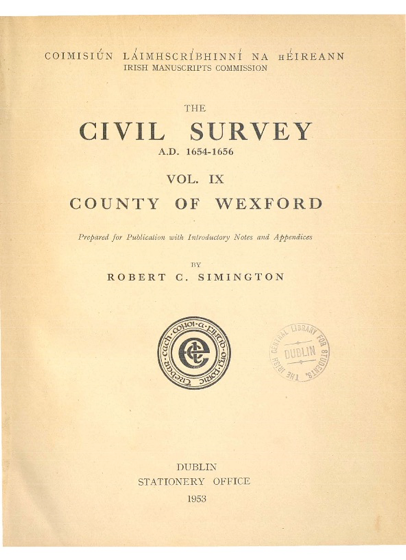
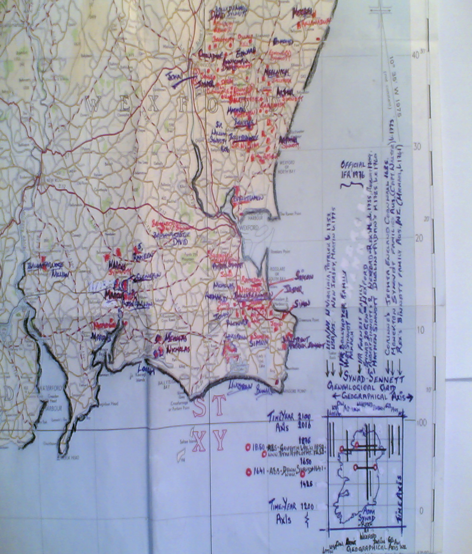
Wexford: Location of Townland-Estates of Sennett Families (No.15)1641, prior to Cromwellian Civil Survey.
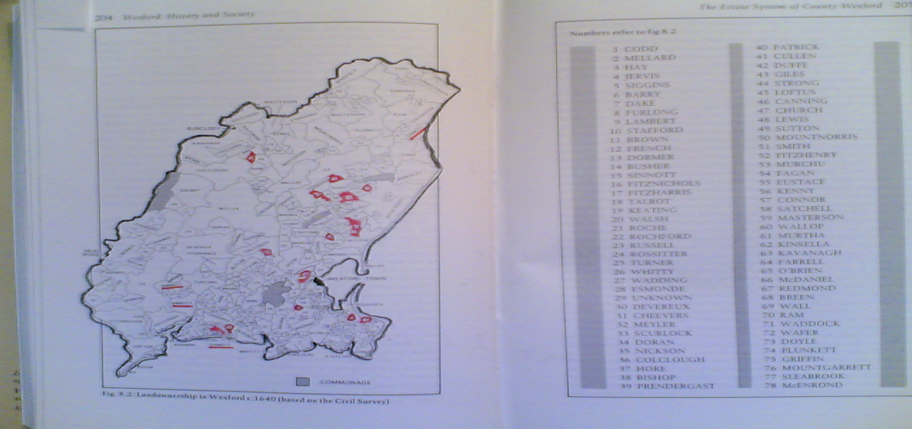
Pre-Cromwellian Wexford Estates (No.15, RHS Listing), p.204, 'Wexford History & Society' Editor Kevin Whelan
Ch.5.6/ Annamult Townland, Danesfort, Bennettsbridge, Kilkenny, (Beul-Bairr, Church &Castle)
http://historicgraves.com/story/annamult-beul-biarr Donal Sheridan & Bernie Kirwan, Tues.6th Dec.2011.
The Gaelic Irish phonetic of Annamult is 'Awe-naw-mult' ("Ath-na-Molt") i.e. Ford of the Wethers. A wether is a castrated ram or goat. Some time between 1221 and 1229, William Marshall Junior., 2nd Earl of Pembroke, "granted to the Abbey of St Saviour of The Cistercian order in Dowyskir" (otherwise Duiske , now Graiguenamagh), for the souls of himself, and of William Marshall Earl of Pembroke, his father, and of the Countess Isabella (FitzGilbert de Clare), his mother, lands, possessions, liberties and free customs, the land of Dowyskir (Dubh Uisce or DarkWater), Athnamolt (now Annamult) for 11 carucates of land. The Townland of Annamult is thus found, at this early date, among the temporal possessions of Duiske Abbey, otherwise Graiguenamanagh, and it continued so till the suppression of the monasteries by Henry VIII, in 1540. Traces of its occupation by monks still remain at Annamult, in the broken ruin called the "Friars Barn", also in the site is the "Friars Chapel" which is still visible at a distance of 100 yards from the Barn. There is also here, just beside the Barn a big ancient castle called the "Friars Castle" and the "Castle of Annamult". The Castle and Barn together with the Chapel and other buildings, now level with the ground, formed the monastic "Grange of Hanumolt" which the Abbot of Graiguenamanagh was forced to surrender to the Commissioners of Henry VIII at the suppression of the Religious Houses and Orders. It stands in the townland of Annamult, about 400yds, east or south-east of the Friars Barn. Its local name is Baeal-bawr, ie. Beul-Bairr (the gap or opening in the hill). The name is perfectly appropriate, as the Church stands in a very narrow gap, towards the northern end of a low ridge. The Church dates from about the 9th Century. It is rectangular in shape, the walls are substantial and built of large stones. All features are now broken or destroyed.
There is no Holy Well nor memory of a patron Saint associated with Beul- Bairr. Major J Grove White (Memorials of the Dead, Vol 2.1892), gave an account of Beul-Bairr as stating the Church was in ruins only for four walls standing. The Churchyard was enclosed by a very substantial stone wall about four feet high, built at the expense of the late Mr Maurice FitzGibbon (the White Knight) of Crohana, Stoneyford, Kilkenny. He also stated that Beul-Bairr was known as Ballyvotten. The Ordinance Survey Map 1839 of Annamult shows a small settlement close to Beul Bairr called Ballyvatten. This boundary wall now has several breaches in it, and is in a collapsed state, and has been replaced by wire fencing (fairly typical in Ireland). The graveyard enclosure itself would be approximately one 1/4 of an acre. All the recorded burials are within the confines of the Church but numerous stones placed in the enclosure suggest unmarked graves. With regard to the 'Holohan family' memorials within, there appears to be variants in how their family name is being spelt. The Lewis Survey of Kilkenny of 1837, Annamult otherwise Athnamolt, a parish in the Barony of Shillelogher, Kilkenny Co, six miles south from Kilkenny Town containing 458 inhabitants. It is situated on the River Nore which here receives the Kings river, on the high road from Stoneyford to Kilkenny by Bennettsbridge, and contains 1664 Statute acres. Mr William Tighe in his Statistical Observations relative to County Kilkenny 1800-1801, wrote, "Mr Neville of Annamult House at the mouth of the Kings river introduced modern improvements, new implements of tillage and good stock". Tighe (1800) also stated that the ancient monastic lands at Annamult were tithe free, and the value of these lands was generally high and well improved.
Eugene Curry: Ordnance Survey letters (1839), ie. notes taken to accompany the Survey
The ruins of the Church called Teampall (Temple) Beal-Barr, in the townlands of Athnamolt, i.e the Ford of the Wethers, the side walls and the gables remain, there is a round headed window in the west gable four feet high and four feet wide on the inside. There is a doorway twelve feet from the west gable in the southside, three feet seven inches wide on the inside. The top is broken away so that its height cannot be ascertained and two of the cut stones only remain on each side. There is a broken window in the same side and a broken doorway in the north wall. Opposite to that on the south a broken window between it and the east gable. There is a round headed window in the east gable. The cut is stone removed from the south side at the front. The walls are two and a half feet thick, well built with large square stones and strong lime and sand mortar. The doors and windows built up with well-cut brown grit stone. There is a small burial ground attached.
There is an old Castle called the Friars Castle about a furlong north of the Church in the same townland, 25 feet by 19 feet, the 1st vaulted floor of which remains. The door is on the east side with the cut stones taken away. It has thirteen windows and sixteen loopholes, but again the cut stones have all been carried away. The walls are 6 feet thick. There is a ruin about 200 yds south of the Castle which they call the Friars Barn. This ruin (the three gables of which remain) is 32 yds long and 15 yds wide having several air holes through the walls, these are 2 feet 6 inches thick. It is referred to as 'Beul Barr'. (Sources appended at the end of Extra Surname Bibliography)
Sources:
1/. Reverend William Carrigan, History and Antiquities of the Diocese of Ossory (Kilkenny Diocese). 1905
2/. Major J Grove White, Memorials of the Dead Vol 2. 1892.
3/. Lewis Survey of Ireland (by County) 1837, and Eugene Curry Ordinance Survey Letters 1839.
"The Synnot Children" of Ballymoyer, Armagh County, Northern Ireland, by (Joseph) Wright of Derby, 1781.
Children of Sir Walter Synnot's 1st marriage (Maria, Marcus, Walter), @ National Gallery Victoria, Melbourne
Kindly donated through Art Foundation of Victoria by Mrs Michael Hawker (née Patricia Synnot, Founder, 1980)
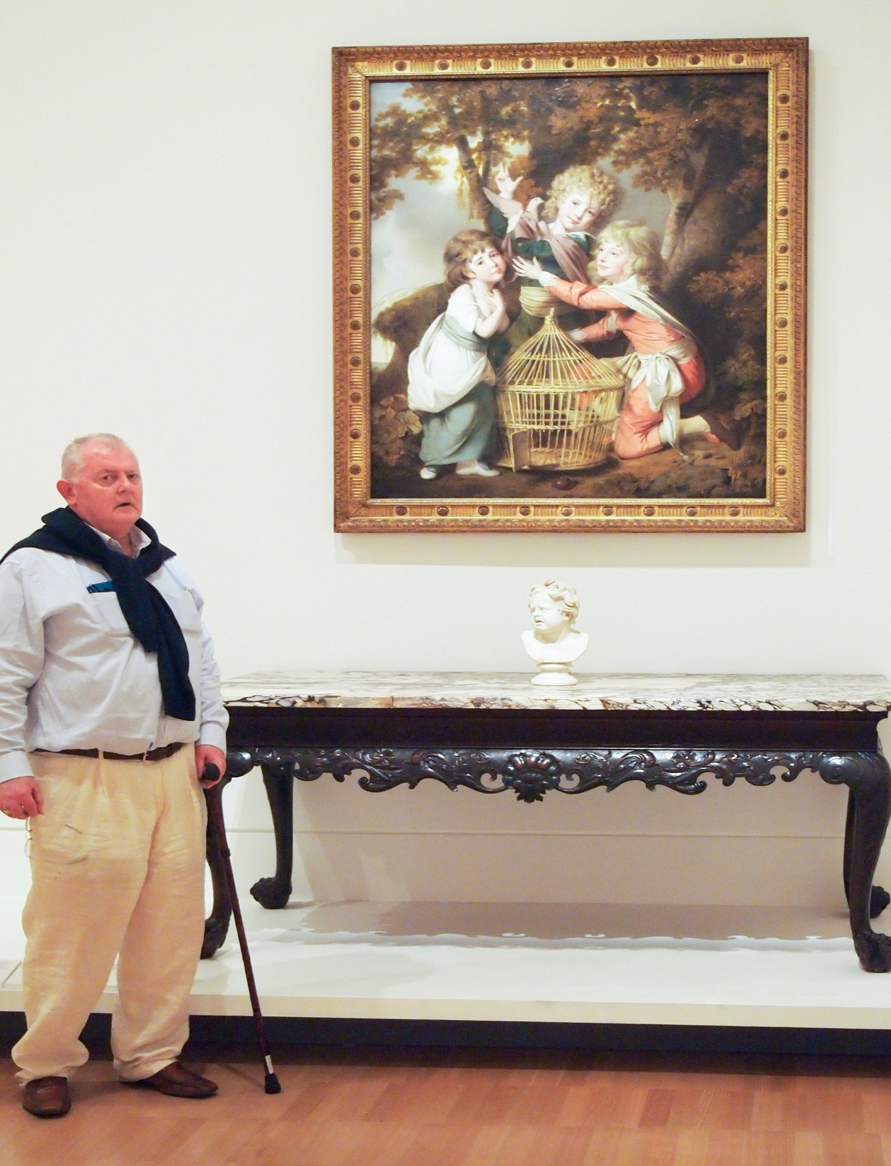
The paper's author (familytreeDNA.com member) at the NGV, Melbourne, by Nigel H. Sinnott (familytreeDNA.com member), March'2018
End www.familytreetDNA.com Any comment regarding Origin's text http://synnott.org below or see HomepageContact
|
Get inTouch/Send Message: 3*** please retain this empty dialogue box as empty, … for future communications |
Chapter 5.7/ Some Earlier Lives (Early American Lives)
Ireland, Britain &Dominions (Australia,Canada,New Zealand), Asian &Women's lives (possibly later appended).
5.7/ Some Earlier Lives:
A full account of the surname worldwide will necessarily touch on the lives of some of the more notable individuals in different parts of the globe at different time periods. Such of these lives that we know of today were briefly touched-on or recounted in published form after the turn of the 18th Century. The earliest published sources of these modern lives were those recorded when Ireland was under British jurisdiction and a Nation within the Union as part of the United Kingdom of Great Britain and Ireland. The Act of Union between the Kingdoms of Great Britain and Ireland was effected in 1801. Subsequent to this time the published record of the surname was initiated and thereafter ever gradually and gently enhanced until the present day.
The earliest serious accounts of the surname were those limited genealogical entries made in the notable sequence of London based 'Burke' hard-back publications during the early Victorian period. These genealogical and heraldic directories were initiated by a prominent genealogist of the time, one John Burke, Senior. This Burke Senior's efforts were continued after his death by those of his 2nd son, Sir John Bernard Burke, later appointed to the Irish heraldic office of 'Norroy and Ulster King of Arms'. The twin and matching standard works in a long sequence produced by this father and son duo would eventually become, The General Armory of England, Scotland, Ireland and Wales, first published 1842 and then 1884, and secondly, The Landed Gentry of Great Britain and Ireland. This book was also known as The Genealogical and Heraldic History of the Landed Gentry of Great Britain and Ireland and was previously first published as A Genealogical and Heraldic Dictionary of the Peerage and Baronetage of the United Kingdom, in 1826. The first work above was purely heraldic in nature, the second being more widely and specifically genealogical. The Irish section of the later of these two works above, after a number of intermediary formats dating from 1899, 1904, 1912 and 1958 would ultimately comprise its single themed final edition of 1976, Burke's Irish Family Records, this being published in London by Burke's Peerage Limited.
Another Victorian source of Sennett genealogy was a 7'page section within an Irish regional publication of 1877 *'The Chronicles of County Wexford down to 1877,' by a George Griffiths, pages 210-to-216 (see Special Note provided at end of Ch.5.7/). The work was produced by The Watchman (Press) Office of Enniscorthy, Wexford. The section cited above contains a detailed and comprehensive account of the wider Sennett/Sinnott family in Wexford for that portion of the 17th Century period upto about year 1670. The full report is believed to have been composed on behalf of the earlier serving Survey Commissioner, William Petty, (and his survey and documentary record of Wexford), before or circa year 1680. The account is supposedly written by a local Roman Catholic priest, one very probably a Sinnott by name. The author of the Chronicles piece, George Griffiths, obtained the account from The Journal of the Kilkenny Archaeological Society, of 1862. The Society would at that time soon be subsumed into The Kilkenny and South-East Archaeological Society, and soon again thereafter, into one of the founding bodies of The Royal Society of Antiquaries in Ireland. The full and rather flattering account of the familyname in Wexford, from an Anglophilic perspective is not reprised here in this particular history. However, the trail of provenance of the lengthy report titled 'Account of the Barony of Forth' is offered as earlier indicated in a footnote at end of the section. (*)
Quite apart from those family histories reported in the Burke series editions (see 'Synnott of Furness' in Burke's IFR'1976 p.1092, reproduced in Ch. 5.6/ above, and also Synnot of Ballymoyer in the 19th Century Burke editions) and the two individual Synnotts recorded in the more recent Dictionary of Irish Biography (Joint Eds., J.Quinn & J. McGuire, published RIA-CUP. 2009, 9 Volumes, Vol.9 p.217-218), the lives related in this account following, have largely gone un-noticed and unremarked in the public, institutional or commercial directories of their time or the many available national and regional histories. Some of these early lives are most notable for their rugged survival from humble beginning, modest prospect and dangerous circumstance. The other noteworthy Sennett lives forged or spent in the USA, UK and overseas Dominions in recent centuries should currently appear in some of the many directories of national biography within their separate jurisdictions. A selection of these Irish, British and Colonial period lives may possibly in time be appended to this Chapter 5.7/ at end of the current section, but only possibly at a much later date.
Early American Lives (USA):
The early Irish-American Sennett families, were very probably originally descended from a narrow cohort of modern period and modest-living Wexford agrarian society of our latter centuries. Some of these emigrant families were penning biographies and carefully recording details of their lives and ancestor's lives, long before it became standard practice and a popular fashion in the western world or in Ireland. Although Ireland as a nation was possessed with the weighty indulgence of genealogical histories, this was so only during its ancient and medieval period. The modern sense of identity has coursed so strongly in the national veins that ancestry and genealogy and the preservation of record never really became an interest of serious concern until most recent times. This was true among much of Irish civil society and of Government agencies alike. In more recent years the Irish Government agencies have made concessions, facilitations and some accommodation to the lobbying conducted by the newer genealogical associations and the old IGRS (founded post-1922, in 1928). This has at last, but only now, borne fruit. The Government side may have discovered like those more used to commercial opportunism, that there is money in family history and naturally more tax revenues in tourism. One can reassure any likely readers that there is certainly no money or prospect of same in single-family surname history.
There have been some remarkable Sennett lives lived in America in past centuries. The further one investigates the past the more remarkable those lives can seem, lives lived mostly in America but essentially begun in Ireland. It seems a miracle indeed that so many have been so competently recorded or chronicled by family, friend, public record or plain good fortune. Just some few of these lives can be briefly mentioned and respectfully recounted to ponder a little the memorable events of which these persons were a small part. By their recall one can hopefully project their lives against the historical context provided within this paper. One might possibly envision their lives, pursuits and motivations even further backward to ages now long past.
Patrick Sinnett (Patrick, a former King's Waiter -a Customs Official, possibly in the Port of Waterford ?)
One of the earlier Irish emigrants to be drawn to US shores was Patrick Sinnett (b. St Patrick's Day, 1752-1850). As a young man he worked for some years with the Customs Officers of the time. Most probably he worked on one of the landing wharves of the Ports of Dublin or Waterford, less likely Wexford or New Ross (it is not really known which). It is unlikely that such a young man could have travelled at such an age to London or Dublin for this role or trade, without being forced to do so under great necessity. An unusual fact among these maritime towns is that of those ports earlier mentioned, the Wexford Ports have been in consistent and slow decline for many centuries. In some ways however, Waterford and New Ross are as central to Wexford and the south eastern region as Wexford Harbour itself. These 3 port towns acted together as legs of a tripod to the corpus of commercial trade among all the south-eastern counties. In Patrick's case one could only guess at the location and full veracity of his early career claims. As for New Ross, Waterford &Wexford ports, 80 years after Patrick's instinctive dash for a better life, many more similarly inclined young men would depart the 3 inland town's navigable piers in the 1840s (incl. a Patrick Kennedy). For a youthful stevedore on the waterfront, work with the Royal Port's customs officials, known as 'King's Waiters', was much less rewarding than it was for the principals, the Patentee Officers of Royal Ports. The Ports of Dublin & Waterford were indeed declared 'Royal Ports' by King Henry II in 1172. The City and Port of Waterford, a riverine port founded in 853 by Vikings, was given its first City Charter by King John in 1215. A Patentee Officer was a licenced and regulated role (never fully, fairly or finely regulated in its practice of trade). In Britain &Ireland it was fee-funded by the merchant marine it served. Its licensees operated on a strict rotational basis and their sub-contracted role was one which existed for about 200 years before 1810. The UK Treasury then claimed its remit for itself for need of its proper control. There were just 20 such men in the 'Port of London' of late 18thCentury. Patrick's story may be true!
It was nevertheless Patrick's good fortune one day to chance his fate and jump aboard ship for the Americas. Once in America he became immediately indentured to Jacob Conrad for passage money, serving 4 years. Patrick spent much of his early life in service of duty to family, farm and emerging nation. Soon into that term with his master, Patrick joined Capt. Skidmore's Virginian Company for Governor Dunmore's short war against Chief Cornstalk's Shawnees. He served under General Lewis at the one big and bloody, but also decisive Battle of Point Pleasant, now West Virginia, in 1774. He then settled briefly in Pendleton County (earlier Rockingham) Virginia (WV). Farming and fighting was a necessity with many young men in those times. In Patrick's fascinating tale, having freed himself of his bond and served one brief war, another occasion of service arrived at his door when the cause which he knew most well was under threat and every prospect looked most bleak.
Patrick Sinnett joined the Revolutionary Army in early 1781 and served under Generals Washington, Wayne and La Fayette. It was not just his own life and liberty he had in mind. He saw battle at Jamestown, then at Yorktown, Virginia, he saw General O'Hara and Cornwallis surrender to Lieutenant General de Rochambeau.
By October 1781 the turmoil was over, the world had turned upside down, the cause was safe and Patrick's dice with his fate would now turn for the better. Within 2 summers Patrick Sinnett had met and married his dear Catharine (nee Heffner/Hevener, Pendleton Co., 1783) and in time they were blessed with a large family. Ultimately Patrick was rewarded with a life nearing 100 years (d. 1850), a span few can aspire to today (even those at desks). He later in 1813, during the period of hostilities with Britain, happily settled in Ritchie Co., WV.
It was one of Patrick's grandchildren, Jacob Sinnett (1815-1862) who, as a civilian and past his prime, became an unfortunate and innocent victim of the cruelties of the Civil War. (The sad incident had resonance with film reels of long forgotten movies, the Tracy, Fonda, Stewart or 'Duke' Wayne period sagas of the 1940s, 50s and 60s). Many families suffered losses then, in Eastern and Western theatres and the deep South, the casualty lists took in all the States. Jacob's loss was but another call to God. He was laid to rest in the Sinnett Cemetery in the Shenandoah Valley. His death had followed the victory of Stonewall Jackson at McDowell (aka Sitlington's Hill) in Highland County, Shenandoah Valley, this a skirmishing and artillery precursor to his successful Valley and 7 Days Campaigns in May and June of 1862. The unfortunate Jacob had been once, at the time of President 'Old Hickory' Jackson, the 'young Jacob'. If truth be told, before he was accosted he had been fending his way to briefly see his son Henry and a neighbour's boy and cousin, Aaron Rexrode, both of the 25th Virginian, Company'E. Patrick and his family's life was eventually and wonderfully compiled in the early 1980s by a fellow gentleman born of West Virginia, a teacher, guidance director and USNavy veteran, Walter L Eye (1924-2002) of Harrisonburg, Virginia. (included in Extra Bibliography, Chapter 5.6/)
Robert Sinnett (Birth entry in Franklin Pierce's Register @ 1728, Worcester, Mass.)
An early but un-indentured life on the American record is that of Robert Sinnett of Blandford, Massachusetts (previously Glasgow), certainly born in Ireland (1695-1774), but like Patrick above and Walter following below, the exact birthplace is unknown. To say Robert was un-indentured on his arrival at Boston, is certainly not to say he was born with a silver spoon in his mouth. He was press-ganged in an Irish port by a British Man-o-War during a period towards the close of a long European war. The particular disagreement in question was one of many between King William III's Britain and his Hollander allies and the French and Spanish Crowns. He would not be the only one of this account to be so kidnapped by the Royal Navy in those times. He gained a rapid escape from his Navy capture soon after setting foot in Boston Harbour, this being about the year 1715. His early life could not have been easy but one way or other through thick and through thin, by 1730 he was living in Hopkinton, Mass. As a man of the Bible, Robert became a pillar of both Congregational and Presbyterian Churches in Hopkinton. He was however cast out and excommunicated from one church for attending the other on a Communion Sunday. Feelings on the matter ran high, even for that time, both faiths being most protective of their own congregations. He disclaimed anything contrary or improper in his observance, the King James Bible in his hands being of both churches and it having no proscription on his sincere Sacrament. He removed to Blandford, Mass., in 1733, passing on to another good life there, at age 80, in 1774.
His 1st born son Robert II b. 1728, died an infant after being Baptised into the Congregational Church of Massachusetts (the birth apparently recorded in Franklin Pierce's New England Register, as stated above). Both Robert's surviving sons James and John took part in the expedition to Crown Point during the Native Indian War in 1755. James, the elder of the two, also marched both times to Fort Ticonderoga in 1775 and 1777 during the early Revolutionary War. He much later bought the Blandford Tavern in 1787 from his dear brother's widow. Robert's love of Bible was carried even to the Christian name of his choice of spouse, his beloved lady Mehebsibah. Within the same family, James Sinnett (1764-1810) born in Blandford was an early pioneer to the successful Granville' Ohio settlement of 1805. James was Robert's grandson. James and his spouse Polly of Blandford and Alberton (nee Mary Isham, m. 1788) had many children and grandchildren. The Granville place-name also has a resonance in Mary E Sinnott's genealogical accounts further below.
Michael Sinnot
Another early-period life in colonial America was that of Michael ('Micah') Sinnot of Harpswell, Maine. He was born in Wexford County c. 1730 (d. 1800). His life was chronicled, as was that immediately above, by a family descendant, the much travelled Reverend Charles Nelson Sinnett in his 'Sinnett Genealogy' of 1910, published by Rumford Press, Concord, NH. In the 1740s as a young innocent and apprentice glove-maker, Michael was treacherously Shanghaied aboard a merchant ship in Dublin Bay. He was taken to Boston for his bounty of passage. So thus did Michael start his maritime life on the rocky forested outcrop of Orr's Island, Maine.
As an indentured servant to the peninsula's master, Joseph Orr, Michael had landed on his feet and was a lucky young man. His master was a straight living and fair minded gentleman forester, fisherman and farmer.
After serving indenture Michael participated in the wars of that time, probably more in sympathy with one cause but sometimes in sympathy with neither. As a lucky man he managed to survive. During the Anglo-French and Great European World War (The 7 Years War, 1756-1763), his earlier experience in Dublin Bay proved of little account. Michael was press-ganged by a British Man-o-War while conducting business in Townsend Harbour, Maine. This was the same fate as that of Robert Sinnett in an Irish port 40+ years before. Soon thereafter Michael found himself on the British side at Quebec with General Wolfe. There he scaled at night Quebec's western cliffs to the Plains of Abraham in surprise to that great adversary, the Marquis General Montcalm. Both great men died of their wounds in the short one hour battle for the City. Michael later also served during the ongoing Native Indian Wars and thereafter of course the Revolutionary War. He is on the record as being with Captain Doyle's Harpswell Company. Michael must have been someone unable to shirk or idle the call of duty even during times when it fell upon his broad but lucky shoulders quite unexpectedly. After the Anglo-French War, he was fortunate to return safely to his dear spouse Molly on one quiet afternoon, one like many others she had endured while waiting for his return. Molly was busy at her chores in the home of old Joseph Orr when Michael's hand fell gently on her shoulder. Molly was Mary Ward, they had married in 1756 at New Yarmouth, Maine. They would spend their settled life, not at Harpswell, but at nearby Sebascodegan Island. The family would in later generations lose many souls to New England seas they knew so well.
Walter Sinnett (Genealogical Register of New England, 1634-to-1692, by Joseph Savage, 1862, source Portland Library,Me. by SSS)
One life on which there is limited information but which deserves some highlight is that of the head of household of probably the earliest Sinnett in the American colonies, that of Walter Sinnett of Boston. He was born in the early 1600s (place unknown) but most probably born and residing near Wexford Town before 1637. Walter transferred to or was taken to America in the early 1600s. In 1638 he received a house and land grant in Milton, Mass. By 1647 both Walter and his wife Mary had joined Boston Church. This was 2 years before Oliver Cromwell visited Wexford and desecrated and destroyed its churches and flocks alike.
Robert's residence in Boston was on Washington St (east side) and bounded by Essex St and Bedford St. Walter's property bounded the yard in which stood "The Liberty Tree" between the years 1646-to-1775, before being felled by red-coats (if not visiting Hessian troops). Walter's surviving family with his spouse Mary; Mary b. 1640 (m. John Sparks 1661), (Elizabeth b. and d. 1642), John, a mariner b. 1643, married with 3 children and d. 1676, (Joseph b. and d. 1648), Sarah b. 1650, and Thomas b. 1652, finally (Isaac b. and d.1654).
Child death was obviously a common sadness in those times.Robert and members of the family at later dates resided in a further 3 States, Maine, New Jersey and Pennsylvania, all probably so Walter could be with his children in adult life. A brief summary of the Walter's life is referenced by two sources, by Reverend CN Sinnett & Mary E Sinnott (below) in their genealogical works. God Bless the Reverend Sinnett, Ms Sinnott & of course Walter Eye. (see Ch.5.6/ Extra Bibliography)
Joseph Francis Sinnott
There was a particular and much later family recorded by this Mary Elizabeth Sinnott of Philadelphia in her work 'Annals of the Sinnott, Rogers, Coffin, Corlies, Reeves, Bodine & Allied Families' in 1905. This was a privately funded and quality account of good intellect and much enquiry published by Lippencott & Co in Philadelphia, Pennsylvania. Mary Elizabeth reports her own family's earliest known ancestors as follows;
James Synnott b.1740 of Castletown, Tara Hill, Wexford and Ann Connor of Ross, Wexford, married in January 1762 at St Mary &St Peter Church, Arklow, Wicklow. The couple had 3 children Pierce, Mary and John (1775-1850), the last mentioned later to be Captain John Synnott. The Captain was present as a young man at Vinegar Hill near Enniscorthy in 1798 during the Wexford Rising phase of the French and American inspired United Irishmen's Rebellion in Ireland of that year. Having participated in an act of treason and rebellion against the King, he was charged, sentenced, imprisoned but escaped. He married Elizabeth Murphy of Monagarrow, Kilgorman Parish in Kilcavan district, in the north east of the County in 1803. They were married just over the north side of the Wexford-Wicklow border at Arklow. The marriage was at the same Arklow church of John's own parent's union. Captain John thereafter, to satisfy some preference, changed the spelling of his name from Synnott to Sinnott (probably and no doubt to avoid connection with an unexecuted sentence). The Captain and Elizabeth had 9 children, of whom six later emigrated to America. Through earlier friendships, some of the family went to South Carolina or even further onward to Georgia. Two of their number eventually fell to yellow-fever in Charleston and Savannah in the years 1854 and 1857. Two of the siblings had earlier died as infants in Ireland. So, only one therefore remained stubborn and resolute at home.
This son John Sinnott, the 4th born and 2nd of 4 sons, served in Donegal's main fisheries port (Killybegs) as one of Her Majesty's Customs Officers, and died in 1877. He had married Mary Armstrong in January 1832 at Kingstown Church (Dun Laoghaire Harbour) in Dublin. Among the great wealth of Captain Synnott's grandchildren, one of John Sinnott & Mary's '14' children (as an alphabetic count, down to letter "n"), their 4th child Joseph Francis Sinnott b.1837, relocated in 1854 via the Port of Derry/Londonderry to Philadelphia on the passenger ship 'Mahongo'. When arrived there he was soon engaged by Gibson's Distillery after which, apart from his spell serving the Union, a successful career was never in danger. Having enlisted early he was mustered out of the Union's Washington Greys in late 1861. This was after that period when Winfield Scott was General in Chief of Federal Armies and McClellan was in charge of the Army of the Potomac (for any non-USA readers, Ulysses Grant assumed overall command much later, March 1864). Joseph had served under Major General Patterson in Virginia (Bull Run/Manassas, Prince William County). He was minded then to decline a commission to Rush's Lancers (Pennsylvanian) under obligation to his insistent employer Gibson.
It was while working for the Distillery Company in its new Boston business that Joseph Francis met his future spouse Annie Eliza Rogers. They quickly married in Boston in 1863, and were subsequently blessed with 9 children. The authoress above mentioned, Mary Elizabeth Sinnott (b. 1865) was the new couple's 2nd born and 1st girl child of the nine children. In her work, Mary Elizabeth provided wonderful sketch prints of the family homes in Pennsylvania, in West Philadelphia and Rosemount. The volume was edited by one Josiah 'Granville' Leach.
James Sinnott
Another James, unrelated to the Captain John's family above, was James Sinnott of Kilkenny who married a Mary Butterfield of Baunta townland, Callan Parish, Kilkenny County. The couple removed to New Orleans in the early 1800s. It was their son James Butterfield Sinnott who served as an Officer in General Lee's Staff for the full extent of the Civil War. James Butterfield Sinnott Junior thereafter, married another Butterfield family lady for himself, Margaret Butterfield of Nova Scotia. Two Butterfields in a row, as strange an occurrence as say, four Samuels in a row, as below.
Some other 19th Century Wexford & Dublin Sennetts in USA & Canada extracted from sources stated above;
1/. Capt. William Sennett (c.17xx-18xx) mariner of Dublin, emigrated from L'Derry, to Arrowsic Island, Maine,
Samuel Sennett (c.18xx-1860) son of Captain William, farmer & shoe-maker, m. Ms Scott of St.David, NB., Can.,
Samuel Sennett (1834-19XX) his son, of St David &Meddybemps, Me., Wesleyan farmer, m.1860 Rhoda Farrell.
2/. Samuel Sinnett (1817-1899) son of John Townsend Synnott of Dublin, silk merchant/glove-maker, of Iowa.
3/. Samuel Sinnott (dates unknown) of Saco River and Kennebunkport, Me., married Annie Meliken (Milliken).
The preceding Chapter 5.6/ reproduces the main Bibliography of this text and an extra Sennett Bibliography of varied publications. The longer Bibliography covers many published family accounts. It includes one of the more formal, traditional and exemplary genealogical sources on Irish families (and a particular Irish Sennett/Synnott family),… Burke's "Irish Family Records". The volume was published by Burke's Peerage Ltd, in London, in 1976. The work contains at least one prominent Atlantic coast American Synnott branch. It is unknow whether such a particularly difficult work as Burkes will be republished again. One hopes it might be reprinted or republished at some point, but that achievement may be unlikely. If it should ever be re-published again, it is a most recommended 'buy' for any Sennett family household.
* A Special Note relating to an Account of the Barony of Forth and its likely provenance (insert, Aug. 2018):
There is an interesting historical and flattering profile of the Wexford Sennetts given in a well known Victorian regional publication under the heading of 'An account of the Barony of Forth, Wexford'. It appears in George Griffiths' volume, 'The Chronicles of the County Wexford' (pps. 210-216), published in 1877 by the Watchman Office Press, Slaney Road, Enniscorthy, Wexford County. The report was also reproduced for the annual Journal of what had been the Kilkenny Archaeological Society (now the RSAI) as an article by the author and historian Herbert F. Hore as editor, and titled 'An Account of the Barony of Forth in the County of Wexford, originally written at the close of the Seventeenth Century, c. 1680'. It was then published in The Journal of the Kilkenny and South-East of Ireland Archaeological Society, in the Journal of the New Series Vol. 4, No. 1 (1862), pps. 53-84, published by the Society. This Society would become The Royal Society of Antiquaries in Ireland, Merrion Square, Dublin D02.
The account is also available at http://www.jstor.org/stable/25502621, the chapter entitled 'An Account of the Barony of Forth'. The provenance of the account according to HF Hore in his prologue to the article is as follows immediately below. The fuller provenance is offered immediately thereafter.
"The original Ms of this tract is in the possession of Sir T. Phillips, Bart., Middlehill, Worcester, with other contemporary accounts of Irish counties and districts, which were written for Sir William Petty. At the time he intended to accompany his Atlas of Ireland with a volume of such treatises. It is entitled:-'A Briefe Description of the Barony of Fort, in the County of Wexford, together with a Relation of the Disposition and some peculiar Customs of the ancient and Present Native Inhabitants thereof.' The date appears to be about 1680. Who the author was is not known: but from the frequent reference to religious matters, the thorough acquaintance displayed with them, the quotations from classic writers, and the circumstance that the citations from the Old and New Testament are in the Latin language, I conjecture that he was a Roman Catholic priest; and, further, that his name was Synnott, because he shows an intimate knowledge of this family."
One might add for our puposes of clarifying its provenance that the original manuscript document was most likely sold at an auction conducted in 1834 by Christies of London. The auction was that of the Library contents of Lord de Clifford's home. A Mr Thorpe, an English antiquarian dealer, purchased a number of the original William Petty documents in that sale. The Lord de Clifford was a member of the Southwell family. The Petty documents were a part of a deClifford ancestor's Southwell manuscripts, the Manuscripts of Sir Robert Southwell of Kings Weston, England, ie Ms.386 (in the sale?). Sir Robert Southwell was Secretary of State to both James II and William III, and a close acquaintance of Sir William Petty in his later life. Much of this latter information is from an 1851 London publication 'The History of the Survey of Ireland - The Down Survey' by Dr. William Petty. It is also found as one of a series of 'Reprints of Economic Classics' as republished by Augustus Kelley Publishing Co. of New York in 1867. The late date of the "Account of Forth", 1680, is due to Petty's late-in-life and unfulfilled intention to assemble a comprehensive directory and anthology to his Irish Survey work along with a descriptive and historical series of county and district reports. The original document itself, if not still held in the private possession of the Phillips family descendant posterity, may now be held in the archives of either the RIA in Dublin or the British Library in London.
ABS. End.
